
10064 PINEROLO - ITALIA Tel. +39 0121393127 info@chiriottieditori.it www.foodexecutive.com Supplemento al n. 09, ottobre 2022 di Industrie AlimentariSped. in A.P.D.L. 353/2003 (Conv. in L. 27/02/2004 n° 46) art. 1 comma 1 DCB TOn. 102 anno 2022IP n. 102 - November 2022 ISSN 1590-6515 FOOD & PACKAGING TECHNOLOGY ITALIAN
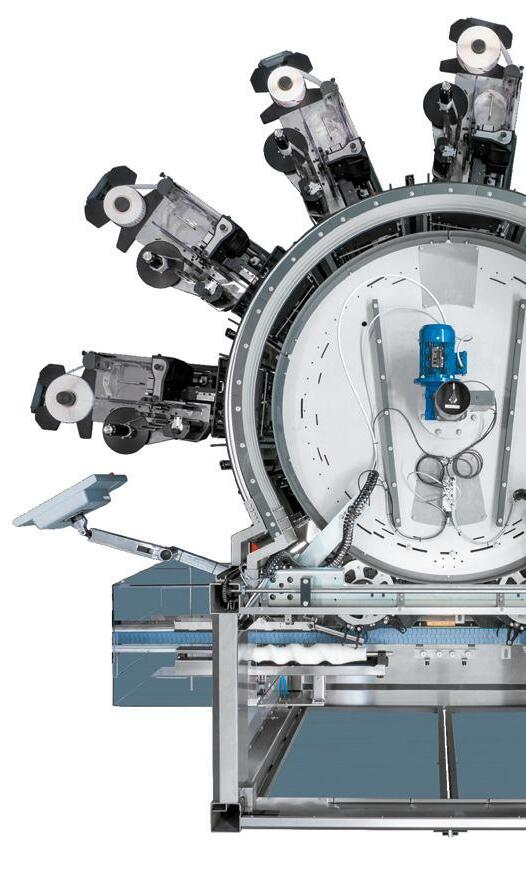
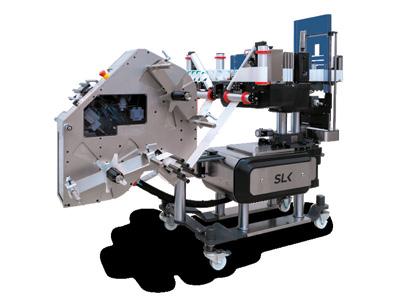


Labelling for Wine & Spirits has never been so effective. CEPQ MODULAR SL SIMEI 2022 is the perfect place to put in the spotlight the best solutions for Wine & Spirits Industry. P.E. Labellers exhibits MODULAR SL fully equipped with labelling stations and special solutions: ◊ new FA-ST 140 m/min units ◊ 6 pressure sensitive labeling stations ◊ the units work in non-stop mode ◊ optical orientation system ◊ capsule presence control device ◊ bottle fall control device Performance, Packaged
PRODUCT TRENDS - Fresh peaches and cherries: world markets and trade - Plant-based meat market worth $8.3 billion by 2025 - Dou bling global potato production in 10 years is possible - Lactose-free products market worth $18.4 billion by 2025 - Spices and season ings market forecast
FOOD PROCESSING - Fruit and vegetable processing market worth $11.8 billion by 2027 - Sublimation fits to today’s healthy food re quirements - New solutions for Servomech screw jacks with brush less servomotors - Clip removing and cutting machine - XMD metal and X-Ray detectable timing belt range - SARP, same passion, new graphic - Tailor-made solutions - Melt continuously and in a small space - A mild and innovative solar drying process to provide high quality products - Impact of ultra-high-pressure homogenization of buttermilk for the production of yoghurt - Impact of overhead pres sure during mixing on the quality of sandwich bread

PACKAGING TRENDS - Bioplastics 2023-2033: technology, market and forecasts - Aseptic packaging demand to grow 5.5% annual ly - Capsules growth is slowing down and competition intensifies in aluminium - VTT develops transparent cellulose film to replace traditional plastic - Researchers develop plastic film that can kill vi ruses using room lights - The microperforated packaging design for fresh-sliced mushrooms
PACKAGING EQUIPMENT - Flexible automation solution for card board packaging - Monobloc case packer with pick & place system - P.E. Labellers at Simei: labeling innovation for wine & spirits - In fluence of room layout on airflow distribution in an industrial fruit store - Automatic tray sealing machine - SKIN packaging technology
NUTRITION - Making butter-like spreads healthier - Quinoa sour dough-based biscuits with high antioxidant activity - Canola and olive oil galled emulsions as fat placers in beef burgers - Cistus ladanifer seeds: from ancient snack to novel and sustainable food ingredient - Bread as probiotic carriers - Oral processing behaviours and taste intensity - Effect of freezing treatment of soybean on soymilk nutritional components - Functional oil/vin egar dressing
RESEARCH - Simultaneous detection of four main foodborne patho gens in ready-to-eat food - Natamycin, a biofungicide for managing major postharvest fruit decays of citrus - Use of oleogels to replace margarine in steamed and baked buns - Genome-edited Saccharo myces cerevisiae strains for improving fermented foods - Micellar casein and cheese product storage - The impact of plasma process ing and pulsed electric field on the viability of probiotic yoghurt drink - Smartphone biosensor for detection of ochratoxin A in wine and coffee - Effect of ozone and antimicrobial treatments on the shelf life of packaged cauliflower
NEWS - Sigep 2023, the “dolce”ß communities begin the countdown - Beer&Food Attraction and BBTech Expo to be held in February - In ternational events in Italy - Macfrut 2023 with many new additions
3
14
30
38
48
54
60
64 COMPANY INDEX departments
NOVEMBER - issue 102
Four-monthly
Chiriotti Editori s.r.l.


Viale Rimembranza 60 10064 Pinerolo - To - Italia Tel. 0121 393127 info@chiriottieditori.it www.chiriottieditori.it

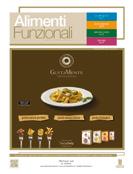


for free subscriptions call to +39 0121 378147 or send an e-mail to: abbonamenti@chiriottieditori.it La riproduzione, anche parziale, di articoli ed illustrazioni pubblicati sulla rivista è riservata e non può avvenire senza espressa autorizzazione scritta dell’Editore. L’Editore non assume alcuna responsabilità per quanto riguarda eventuali errori contenuti negli articoli e per quanto espresso dagli Autori.

Publisher

Alberto CHIRIOTTI Direttore Responsabile alberto@chiriottieditori.it
Contributing
Laura SBARATO, Simonetta MUSSO, Rossella CONTATO, Matteo BARBONI
Assistant
Chiara MANCUSI mancusi@chiriottieditori.it
Anna BOSCOLO
All Rights reserved. Reproduction, even partial, of articles and illustrations published in the journal is forbidden and can not take place without written permission of the Publisher. The Publisher assumes no responsibility for any errors contained in the articles and for what is expressed by the Authors and/or by the companies.
PRINTED by Graf Art
COPYRIGHT: © 2022 Chiriotti Editori
Monica PAGLIARDI pagliardi@chiriottieditori.it
Luca RUSSO russo@chiriottieditori.it
Giuseppe CHIRIOTTI
: n.
(19-11-1962)
Tribunale di Pinerolo
mensile
20/B,
662/96
www.chiriottieditori.it




- ISSN 1590-6515 November issue 102
Editors
Editor
Graphics
Marketing Manager
Advertisement
General Manager
Unione
Stampa Periodica Italiana Copyright Clearance Center
Officine Grafiche Artistiche Venaria (To)
srl Supplemento del mensile “Industrie Alimentari” AUTORIZZAZIONE
262
del
PERIODICITÀ:
- sped. in A.P. comma
art. 2, legge
Torino INTERNET:
OUR WEBSITES www.chiriottieditori.it shop.chiriottieditori.it www.foodexecutive.com www.pasticceriainternazionale.it www.tuttogelato.it www.alimentifunzionali.it
PRODUCT TRENDS
Fresh peaches and cherries: world markets and trade
FRESH PEACH AND NECTARINE HIGHLIGHTS
According to the latest report published by the Foreign Agricultural Service of USDA, the world peach and nectarine production in 2022/23 is fore cast to edge up 1.0 million tons to 23.7 million on rising output by China, European Union, and Turkey, the world’s top producers. Exports are expected to be nearly unchanged as higher shipments from Uz bekistan and China offset lower EU and U.S. trade.
China
Here the production is projected up 800,000 tons to 16.8 million due to higher yields on good growing conditions, especially in southern China. However, planted area continues to shrink as declining market returns encourage growers to switch to more profit able crops, including cherries. Exports are forecast to rebound due largely to the resumption of shipments to Russia. Russia banned fresh fruit imports from China, including stone fruit, due to pest concerns in August 2019, lifting restrictions in February 2022. Renewed shipments to Russia are expected to help boost exports 10,000 tons to 55,000. Imports are also anticipated to rebound to a record 43,000 tons on higher shipments from Chile in the beginning of the marketing year (January-December).
EU
The production in EU is forecast to improve to 3.1 million tons as supplies in France and Greece rebound from last year’s weather damage, more than offset ting significant losses in top grower Spain. Aragon and Catalonia experienced intense cold and severe
frosts in April and May, dropping Spain’s output by 30 percent. With the majority of EU exports sourced from Spain, EU shipments are likewise expected to contract, down 12,000 tons to 125,000. Reduced output is expected to boost imports 7,000 tons to 50,000.
Turkey
In this Country the production is forecast up 48,000 tons to 940,000, an eighth straight year of growth, driven largely by growing nectarine supplies. Peach acreage accounts for the majority of growing area and output, but acreage has remained relatively stable since 2012/13. Nectarine acreage is steadily growing, spurred by an increasing consumer prefer ence for nectarines in domestic and foreign markets.

italian food & packaging technology - cii (2022) - november 3
Despite higher supplies, exports are forecast to con tract slightly to 165,000 tons on reduced shipments to Russia.
U.S.A.
The production is expected to drop over 100,000 tons to 605,000 due to late winter and early spring freezes impacting crops in the top three growing states of California, South Carolina, and Georgia. U.S. production has halved since 2010/11, and is forecast at the lowest level since at least 1982/83 (the earliest year within the USDA Production, Sup ply and Distribution database). Reduced supplies are anticipated to pressure exports lower to 70,000 tons, while imports are up to 35,000 tons, mostly from Chile where output is up.
Chile
Production in Chile is expected to continue its long upward trend, rising to 180,000 tons on favorable growing conditions and improved winter rainfall. Rising nectarine output continues to outpace peach produc tion as growers expand nectarine acreage in response to higher nectarine returns. Exports are forecast up 8,000 tons to 120,000 on higher production.

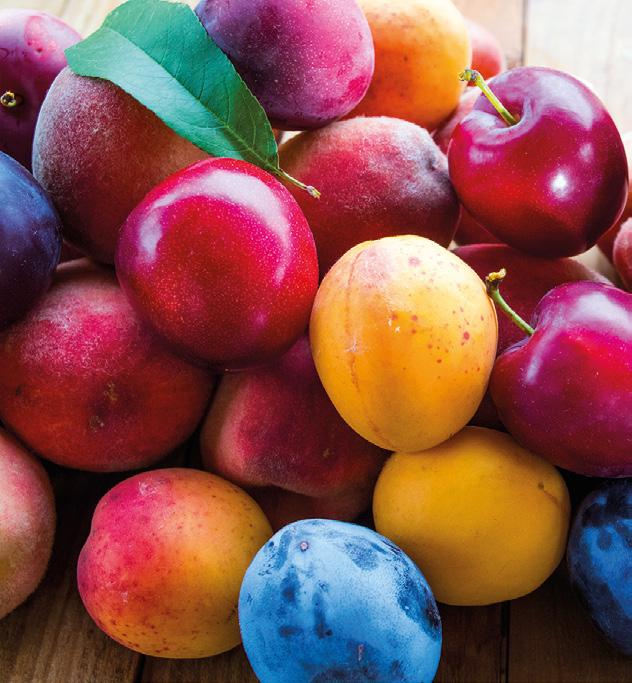
Russia
Russian imports are forecast down 20,000 tons to 230,000 as reduced shipments from Turkey are only partially offset by gains from Uzbekistan and renewed supplies from China. Despite this second
straight year of declines, Russia re mains the top importer and normally accounts for 30 percent of world trade.
FRESH CHERRY 2022/23 HIGHLIGHTS
Regarding the world cherry pro duction in 2022/23 is forecast up over 220,000 tons to 4.7 million largely on surging output in Turkey and Chile. Great er supplies are expected to lift imports slightly to 630,000 tons on higher ship ments to the European Union and China.
Turkey
In this Country the production is expected to rebound from last year’s weather-damaged crop, surging over 100,000 tons to 980,000 as yields rise on favora ble weather conditions and good rainfall. Though
4 italian food & packaging technology - cii (2022) - november product trends
planted area has been declining for several years, this is being offset by growers replanting orchards with high-density and high-yield varieties. Exports are forecast up 9,000 tons to 80,000 on higher supplies, lifting Tur key past the United States yet again to become the second largest exporter behind Chile.

European Union
The EU production is anticipated to see a recovery from last year’s adverse growing conditions, rising 60,000 tons to 727,000 as good growing conditions in Poland, Italy, and Greece offset heat and drought-induced losses in Spain, Portugal, and Hungary. Consumption is expected to rebound 80,000 tons to over 770,000 propelled by improved domestic supplies and higher imports. Greater shipments from Turkey and Chile are forecast to
boost imports to a record 60,000 tons. Exports are expected to contract again to 15,000 tons as mar kets remain limited following Russia’s 2014 ban of certain EU agricultural production, including fruit.

Chile
Here the production is forecast up almost 20 percent to 467,000 tons as higher rainfall and good growing conditions during the winter boosts yields. Acreage is also up as new plantings contin ue to come online. Higher supplies are expected to drive exports over 50,000 tons to 410,000. The vast majority is still likely to be shipped to China, but exporters are working to diversify markets, such as Vietnam. Shipments to Vietnam com menced in 2021/22 after gaining market access in October 2020. Processing capacity is becoming a concern in the face of increasing output, as the industry works to improve the speed and efficiency of post-harvest processing to ensure fruit quality remains consistently high.
China
Production in China is forecast up 50,000 tons to 650,000. The leading province of Shandong suffered significant losses due to higher temperatures and drought during pollination, but this is expected to be offset by gains in northwestern and southwestern provinces on good growing
italian food & packaging technology - cii (2022) - november 5 product trends
www.fas.usda.gov
Plant-based meat market worth $8.3 billion by 2025
According to the report Plant-based Meat Market by MarketsandMarkets , the global plant-based meat market size is es timated to be valued at USD 4.3 billion in 2020 and it is projected to reach USD 8.3 billion by 2025, recording a CAGR of 14.0% in terms of value.

Growing vegan and flexitarian populations across the world, rising awareness about the health benefits offered by plant-based meat over animal meat, and growth in government initiatives along with significant investments are driving the global plant-based meat mar ket.
The soy segment accounted for the largest share
Based on sources, soy dominated the plant-based meat market. Soy serves as an alternative to meat sources such as pork, beef, and chicken, owing to its high protein content. Traditionally, the consumption of soy and soy products is associated with the Asian population. However, the consumption of soy foods has recently risen in Western countries, owing to the increase in the adop tion of vegetarian diets. Soy-based foods are cholesterol-free against animal protein foods and serve as a source of fibers, vitamins, and other essential nutrients. Plant-based meat
6 italian food & packaging technology - cii (2022) - november
producers are increasingly incorporating soy to make products such as burgers, meatballs, and sausages.

The strips & nuggets segment will mark at a significant growth rate
By product, the plant-based meat mar ket is segmented into burger patties, strips & nuggets, sausages, meatballs, and other products such as slices, fillets, cutlets, slides, fingers, and crumbles.
They are a healthier alternative to meat and are environmentally more sustainable, which is why more food manufacturers are developing plant-based meat products. Several start-ups are going mainstream with the launch of plantbased burgers, nuggets, sausage, meatballs, and other products. Impossible Foods Inc. (US) and Beyond Meat (US) were among the key players to enter the plant-based meat market. These companies are backed by various types of investors, including leading players such as Tyson Foods (US).
The North American region is also expected to grow at the highest CAGR
North America is the fastest growing region in the global plant-based meat mar ket. For American consumers, meat is a very prominent part of their diets. However, as many researches highlighted the health risks related to the consumption of red meat, consumers are increasingly shifting toward plant-based diets as they are a healthier option as compared to animal meat. Further more, Consumers in the region are adopting a flexitarian lifestyle and are incorporating plant-based foods in their daily routine diets.
Along with this, the trend of veganism is gaining momentum in the region, which is further contributing to the growth of the plant-based meat market. Governments are also investing heavily in the plant-based protein industry, as there is a rise of vegan and vegetarian eating.
italian food & packaging technology - cii (2022) - november 7 product trends
www.marketsandmarkets.com
Doubling global potato production in 10 years is possible

Potatoes could contribute even more to world history and global food security, and total pro duction of the food crop could double in the next 10 years, QU Dongyu, Director-General of the Food and Agriculture Organization of the United Nations (FAO), said in his keynote presentation to the 11th World Potato Congress (WPC) convened in Dublin.
Potatoes are the world’s third most important food crop and are regularly consumed by billions of people. They also generate income for smallscale producers, offer a low-fat, high-fibre source of healthy carbohydrates rich in antioxidants and nutrients, and also generate fewer greenhouse gas emissions than other major crops, said Qu, an acclaimed expert on the food crop. Earlier in his career, he inter alia helped organize the 2015 WPC in China and served as a Trustee of the Inter national Potato Center.
Today potatoes, whose genetic origins are in South America, are cultivated on more than 20 million hectares in 150 countries for a total global output of 359 million tonnes in 2020. By focusing on improving yields and making full use of histor ic potato cultivation areas, worldwide production can be raised to 500 million tonnes in 2025 and 750 million tonnes in 2030, the Director-General said.
8 italian food & packaging technology - cii (2022) - november product trends
“Potato will become one of the advantage crops in the global food security system when the yield of other cereal crops is close to the lim it,” Qu said.

While hailing the genius of the peoples of Peru and Bolivia who domesticated the potato, the Director-General noted that Asia and Africa are the regions with the fastest growth of po tato production today, while output is declining in Europe and North America. Globally, potato output has grown even as the land devoted to their cultivation has decreased, highlighting the role of improved yields, said Qu.
The road ahead
The Director-General called on multiple part ners to help “greatly improve” potato agrifood systems on the national, regional and global lev els.
Noting the importance of providing decent rural employment, offering nutritious food and emphasizing the need for inclusive policies, plans and actions, he called for increasing support for potato genetic improvements and shorter breed ing cycles for potato varieties, and the potential value of virus-free potato seed systems.
The International Potato Center gene bank in Lima has conserved more than 7,000 different native varieties and wild relatives, which have a wide range of traits, including the ability to adapt to different production environments and to resist various pests and diseases. Qu empha sized that the relatively low natural resource requirements of potatoes makes them an im portant food crop for people to survive during famine and disaster relief. In China, potatoes are regarded as the preferred crop for increasing in come and reducing poverty, he said, noting the plant’s spatial distribution in the country closely maps that of formerly poor areas, especially in mountainous areas.
italian food & packaging technology - cii (2022) - november 9 product trends
www.fao.org
Lactose-free products market worth $18.4 billion by 2025
According the latest report by MarketsandMar kets, the global lactose-free products market size is estimated to be valued at USD 12.1 billion in 2020 and is projected to reach USD 18.4 billion by 2025, recording a CAGR of 8.7% during the forecast period. The demand for lactose-free products is increasing significantly due to the rise in lactose intolerant pop ulation across the globe. Moreover, the rise in the consumption of clean label food products is one of the major factors encouraging the growth of the lac tose-free organic products market globally.
The cheese segment is projected to witness significant growth
Based on type, the cheese segment of lactose-free products market is projected to witness significant growth rate during forecast pe riod due to the increase in con sumer interest and importance of lactose-free cheese as an in gredient in the food industry, as it offers similar nutritive values to regular cheese. In addition, it is among the popular and pre ferred breakfast ingredients, which is majorly consumed with breads and offer natural, as well as authentic taste.
The inorganic segment is projected to account for a major share in the lactose-free products
By form, the lactose-free products market is seg mented into organic and inorganic. Low cost of prod ucts and ease in the processing of inorganic products

are the key factors encouraging the high adoption of inorganic lactose-free products across the globe. Furthermore, the price of inorganic lactose-free milk is nearly half the price of organic lactose-free milk, which helps in catering to consumers that are not looking for premium products.
The North America region dominated the lactose-free products market
The lactose-free products market in North Ameri ca is dominant due to the growing demand for differ ent types of lactose-free products such as drinkable yogurt, flavored ice-cream, and flavored milk. Also, the North American population has awareness and self-diagnosis for lactose intolerance. In addition, the increase in no sugar or reduced sugar trends are factors that are projected to drive the growth of the lactose-free products market in the region.
The fastest growing market is Asia-Pacific for lactose-free products market. The increase in disposable income among consumers and the demand for health and wellness products have encouraged the consump tion of lactose-free products. The increase in urbanization in the region has led to a high demand for food security and premium quality food products. Consumers are willing to pay extra for health-enrich ing food & beverage products. These factors are pro jected to encourage the growth of the lactose-free products market in the region.
10 italian food & packaging technology - cii (2022) - november product trends
www.marketsandmarkets.com
FOOD SECURITY
Listeria risks the remedy is HPP
The power of the High Pressure HPP ITALIA, your reliable partner able to provide the innovative hyperbaric HPP treatment for all perishable products.
In HPP ITALIA we treat the products at very high hydrostatic pressure (thousand atmosphere) inducing in this way the bacterial inactivation: an innovative cold process thanks to which food, stabilize and safe, keep unaltered its precious nutritional and organoleptic elements.

Thanks to the HPP technology (High Pressure Processing) your products can increase their shelf life safely!
We were first in Italy to provide the High Pressure Treatment for third parties and we guarantee maximum confidentiality.
Discover more about the extraordinary potential of our HPP treatment booking your free tests on hppitalia.it
HPP Italia srl Parma - Italy - info@hppitalia.it
Brand protection H24 Security Export no limits
Spices and seasonings market forecast

MarketsandMarkets released a report on the “Spices and Seasonings Market where global trends and fore cast to 2026 are analysed.
The global spices and seasonings market is expected to grow from USD 21.3 billion in 2021 to USD 27.4 billion by 2026, at a CAGR of 5.2% from 2021 to 2026. Globally, the spices & season ings market is driven by the growing demand for convenience food prod ucts, clean label trends, and natural preservatives for the meat industry. However, the growing incidences of adulteration and contamination in the spices exported from developing countries such as India and China are prompting regulatory bodies in Eu rope and America to strengthen the safety regulations on imported spices and seasonings. Growth in food prod uct innovations to incorporate natural ingredients, increase in demand for health and wellness products, and rise in demand for ethnic and authentic food products are emerging oppor tunities for the spices & seasonings market.
12 italian food & packaging technology - cii (2022) - november product trends
Ginger is estimated to hold the largest market share
Among product types, ginger account for the largest share in the global market. Spice ginger is obtained from the underground stems or rhizomes of Zingiber officinale, a herbaceous tropical peren nial belonging to the family Zingiberaceae. Ginger is largely a universal spice, although its use is more pre dominant in certain countries such as China. Ginger is used in cooking in various forms, such as immature ginger, mature fresh ginger, dry ginger, ginger oil, ginger oleoresin, dry soluble ginger, ginger paste, and ginger emulsion. It is a popular home remedy for nausea, stomach pain, and other health issues.
Antioxidants and other nutrients in ginger may help prevent or treat arthritis, inflammation, and various types of infection.
Conventional spices, by nature, is estimated to account for the largest market share

The conventional spices segment dominated the spices and seasonings market in 2020. Conventional spices are grown using synthetic chemicals, pesti cides, fungicides, and insecticides for the cultivation process. These chemicals harm the crops and reduce their nutrition level. So before even the processing begins, crops are subjected to harsh chemicals that hinder their quality. To grow more produce, fertilizers are used, but in turn, they damage the land and drain its fertility. Many unfair and unethical trade practices aim to gain more profit in selling the bulk-produced stock of conventional spices. One of them is to add harmful and artificial colors and flavors to the spic es to reduce the cost of production. High-demand spices like turmeric powder and red chili powder are adulterated with food coloring, corn starch, sawdust, brick powder, and lead chromate. These adulterated products are sold at a low cost, but their quality is ex tremely low. These harsh colors and chemicals affect human health and disrupt the normal functioning of the human body. However, since spices are used in really small quantities in food, the consumption of properly tested and certified conventional spices does not pose any threat to human health.
Asia Pacific is estimated to hold the largest market share
The Asia Pacific market accounted for the largest share in 2020. The Asia Pacific region is projected to be the fastest-growing market for spices & season ings, at a CAGR of 4.4% from 2021 to 2026. The us age of spices and seasonings in the industrial sector is less in the Asia Pacific region as compared to that in developed regions, which presents food process ing industries with considerable untapped potential. The overall economic growth in the Asia Pacific re gion has led to an increase in urbanization and rapid industrialization, with a resultant rise in per capita in come. These factors play a major role in the changing preference of consumers towards value-added food products.
italian food & packaging technology - cii (2022) - november 13 product trends
www.marketsandmarkets.com
FOOD PROCESSING
Fruit and vegetable processing market worth $11.8 billion by 2027
The report “Fruit and Vegetable Processing Market published by MarketsandMarkets shows that this sector is estimated to account for nearly USD 8.7 billion in 2022 and is projected to reach a value of nearly USD 11.8 billion by 2027, growing at a CAGR of 6.4% from 2022.
In the 21st century, globali zation has led to an increase in trade and resulted in aggressive R&D initiatives by several food & beverage manufacturers. Ad vanced technologies for food ingredients and food processing include membrane technology, su per-critical fluid technology, and molecular techniques such as Pol ymerase Chain Reaction (PCR) and High-Pressure Processing (HPP) technology. Other new processing technologies use non-thermal preservation techniques such as pulsed electric fields, ultrasound, pulsed light, and hurdle systems to maintain the texture and fresh
ness of the food products. Devel opment of new machinery and enhancement of the existing ones are the key strategies adopted by many players in the fruit and vegetable processing market. In addition, increasing focus on the expansion of facilities, marketing schemes, and information ex change programs to create aware ness and enhance the applications of fruit and vegetable processing is projected to contribute to the growth of the market.
The growth of the processed fruit and vegetable market is at tributed to the increasing trade of ready to eat food among countries such as Mexico, Brazil, Argentina, the UAE, India, and China. Fruit and vegetable processing helps in transforming fresh produce into processed fruits and vegetables with increased shelf life through various physical and chemical techniques. The processed fruit and vegetable is witnessing signif
icant growth due to the increasing consumption of fruits and vegeta bles in developing countries such as India, China, South Africa, and Brazil, compelling manufacturers to increase production.
Drivers: Growth in the demand for convenience food products
The processed food market is driven by the increase in the need for convenience due to the busy customer lifestyles. Further, growth in per-capita income has resulted in greater demand for ready-to-eat and on-the- go food items. This, in turn, has led to an increase in demand for processed fruit and vegetable products. The outlook on the growth of fruit and vegetable processing market is projected to remain positive due to the high growth in the fruit and vegetable processing industry.
Consumers are also benefited by the purchase of processed food
14 italian food & packaging technology - cii (2022) - november
products, as it is easy for them to use, consume, and store for a longer period. Consumer prefer ences in developing countries, such as China, India, Brazil, have wit nessed a gradual transition from traditional homemade breakfasts and snacking meals to ready-toeat products over the last couple of decades.
Opportunities: Growing demand for Vegan food products
Over the last few years, there has been growing interest in the development and production of plant-based alternatives to meat. Manufacturers of plant-based foods are capitalizing on the use of fruits & vegetables, legumes, and pulses; they are also mulling over fruit-based products be cause of their nutritional compo sition and superior functionality, which can bring upon textural and flavor enhancements.
Challenges: Physiological deterioration and infections
The fresh produce value chain is a basic and monumental aspect of agricultural production. Among many other factors, it affects the quality of products for consum ers, profit margins for farmers, and export conditions and conse quences for a country. There can be an increased risk in the rate of loss because of normal physiolog ical changes caused by conditions that increase the rate of natural deterioration, such as high tem perature, low atmospheric humid ity, and physical injury. Fresh pro duce, when subjected to extremes of temperature, atmospheric modification, or contamination, abnormal physiological deteriora tion is often observed. This may
cause unpalatable flavors, failure to ripen, or other changes in the living processes of the produce, making it unfit for use.
The vegetable segment is estimated to account for the largest share in 2022
On the basis of fruit and veg etables type, the vegetable seg ment is estimated to dominate the processed fruit and vege tables market in 2022. In recent years, China is being observed as an emerging country in the pro cessed fruit and vegetables mar ket due to the growing demand for healthy, organic and vegan food products.
The fresh fruit and vegetable segment will be the fastest-growing segment

During the forecast period, the fresh fruit and vegetables segment is projected to grow at the highest CAGR in the pro cessed fruit and vegetables market, in terms of value. This segment is estimated to grow
due to the increasing demand for ready-to-cook produce. Thus, due to the busy consumer lifestyles, demand for convenience food, growth in health awareness, de mand for fresh and fresh-cut fruits & vegetables that save preparation time, and convenient storage & longer shelf life are expected to drive the market for processed fruits & vegetables.
The Asia Pacific is estimated to dominate the market in 2022
The Asia Pacific is estimated to account for the largest market share in the processed fruits & vegetables market in 2022. The fruit & vegetable processing in dustry in developing economies such as Asia Pacific and South American countries has devel oped due to factors such increas ing number of working women and middle-class population, bulk production of various agricultural products, and government sub sidies in countries such as India, coupled with trade liberation.
www.marketsandmarkets.com
food processing italian food & packaging technology - cii (2022) - november 15
Sublimation fits to today’s healthy food requirements
Today, PIGO is one of the few companies in the world that of fers all three main methods of preserving food under one roof: freezing, drying, and freeze drying.
“We have improved existing technologies, obtaining the fi nal product of clearly superior quality”, they explain. “We can define as common request im provement of energy efficiency, preservation of raw material nutritional values and character istics, guaranteed bacteria free processing technology”.
What is the peculiarity of the product sublimation process?
Freeze-drying, or lyophiliza tion, removes moisture from raw,

frozen product through a vac uum system and process called sublimation. The ice contained in the product is sublimated, hence transformed from solid to gas and then trapped inside the conden sation system. At the completion of the process, the treated prod uct will have retained its form, volume and original structure, as well as all its physical, chemical and biological properties.
It can then be stored for an almost indefinite time. As the product is porous, it can be re dissolved by the simple addition of a proper solvent. The process also preserves the actual color and shape of the original raw ma terial, reassuring consumers they are actually getting real fruits and vegetables.
At what stage the product sublimated?
Raw material for freeze drying (sublimation drying) is IQF frozen product. Placing IQF frozen ma terial in vacuum chamber, with proper vacuum, adequate (low temperature) heating, and effi cient sublimated ice vapors catch ing, as result client is obtaining final product completely without water, with almost unlimited shelf life, with outlook of fresh or fro zen product, and with preserved all nutritional values in it.
What make huge difference between PIGO EFD (EASY Freeze Drying) System and other con cepts, is the extraordinary ener gy efficiency, both in heating and cooling part of system, what is easy to demonstrate using the facts and clients experience.
Only available absolutely hy gienic and sanitable system on the market is PIGO EFD, provid ing easy approach to all system components, and fully sanitation provided.

food processing 16 italian food & packaging technology - cii (2022) - november
PIGO technologies for food preservation.
Air-dried, on the left, vs. freeze-dried fruits with PIGO equipment.
Being only system not re quiring fixed “monoral” trolleys transportation system, it is also unique easy transportable freeze drying system, suitable for easy transferring from one location to other. Appart the fact that absence of “monorail” system means also lower investment costs.
What is the drying power?
In order to accelerate drying process, we introduce certain quantity of energy, to help inten sity of sublimation process. Using always indirect (radiation) heat ing at low temperature, it is pro vided minimum energy require ments. It is resulting with total energy consumption of around 2 kW/kg of starting product.
Which products can be processed with the EASY Freeze Dryer technology? How are products prepared before processing?
Freeze drying is suitable and applicable for almost all kinds of products such as fruits, berries, vegetables, spices, milk, meat, fish, mushrooms, coffee, yeast, and ready meals.


Products are simply frozen be fore freeze drying, with possibility also to store them for long period of time before freeze drying pro cess is applied. The advantages are connected with the absence of exposure of the product to high temperatures; this allows to ob tain dry materials without losing their structural integrity and bio logical activity. Most proteins do not undergo denaturation and can be stored for a long time.
Why is it beneficial to sublimate products? How popular are sublimated products in the global market?
It allows frozen foods to be dried directly by vaporizing micro cristals of ice without ever having the water melt; it also avoids the breakdown of cell structure into a mushy product. Freeze dried products are characterised with many years long shelf life (once properly packed after freeze dry ing), preserved taste, colour, nu tritional values characteristics of
fresh product, very light weight (total absence of water inside the product), and no any particular storage conditions requirements.
How do IQF freezing tunnels work?
For the perfect IQF freezing process before lyophilization the best solution is EASY Freeze IQF Freezer. Full controlled fluidisa tion method keeps the product constantly suspended above the belt in a cushion of air. The result is the immediate crust freezing and efficient core freezing of indi vidual pieces, regardless of type, variety or condition of product. Maximized freezing efficiency is guaranteed for each unique product, whether the product is heavy, light, soft, sticky or fragile, thanks to variable speed control of all fans and all other build-inn drives, allowing on-the-fly opti mization of air flow conditions.
(PIGO - Via dell’Edilizia 142 -Vicenza - Italy - Tel. +39 0444 905709 - email: info@pigo.itwww.pigo.it)
food processing italian food & packaging technology - cii (2022) - november 17
Lyophilized berries with EASY Freeze IQF Freezer (PIGO).
New solutions for Servomech screw jacks with brushless servomotors

Among the innovations im plemented by Servomech, a new universal motor adapter is now available to be combined with the range of ball screw jacks and acme screw jacks, thus allowing to combine the high performance mechanics of Servomech with the servomotors of the main brands in trade. The new motor adapters for brushless servomotors, like the whole range of Servomech products, are always made inside Servomech factory in Anzola dell’Emilia (Bologna - ITALY) and are available as standard com ponents with a great advantage in terms of faster delivery times and competitive costs.
Servomech, which has always been at the forefront in the search for new solutions for linear motion, promotes a new concept in lifting systems, with an innova tive approach, focused on the ap plication of its high-performance ball screw jacks, with brushless motors and related drives and controls. Customers and design ers are free to choose the brand of motors and drives they prefer. Thanks to the new universal mo tor adapter, the motor connection is now optimized for the use of servomotors with square flange, allowing a simple and immediate coupling with all the main servo motors on the market.
The next generation of lifting systems proposed by Servomech allow you to reach high linear speeds, high dynamic operations with relevant acceleration and de celeration, high positioning accu racy, exact position repeatability and operations with a continuous
duty cycle. The synchronism be tween the various lifting points is carried out in the electrical axis, with the control in position or in both position and torque. The use of ball screw jacks equipped with servomotors, absolute multiturn encoders and drives capable of managing the motion capability of the motors and the control of the required current, allow for reaching high speed, precision and repeatability performance.
The traditional lifting systems are in low linear speed applica tions, with intermittent operating cycles, preferably with the use of acme screw jacks. Through different configurations depend ing on the needs and dimensions and through the mechanical con nections with connecting shafts, mechanical couplings and motion transmission reducers, the screw jack with motor transmits the movement to the other lifting points through a mechanical syn chronism. This solution has some limits, mostly related to linear and rotation speed, inertia masses in volved and the lost power in the various transmission components, vibrations, noise and play that can be created between the mechani cal connections, and the uncertain accuracy of the positioning of the various lifting points.
The new generation of lifting systems proposed by Servomech therefore broadens the applica tion horizons of lifting systems in general with a modern and ad vanced approach. Lifting systems can now be used for continuous operations, for process functions, with also heavy load working cy
Universal motor adapter (Servomech).
cles, with highly dynamic condi tions, high speed, high accuracy and control.
Servomech Spa was founded in 1989 and from the very be ginning has followed the entire production cycle internally within its factories in Anzola dell’Emilia, in the Bologna area. Specialized in linear actuators, acme and ball screw drive, ball screw jacks, acme screw jacks, bevel gearboxes, ball screws and nuts. Appreciated in all European Union countries and industrialized countries around the world, Servomech provides to the market a wide range of high quality and performances prod ucts for the linear motion, and ensure top flexibility and care for its customers.
(Servomech - Via Monaldo Ca lari, 1 - 40011 Anzola dell’Emilia -BO - Italy - Tel +39 051 6501711 -email: info@servomech.comhttps://servomech.com)
food processing 18 italian food & packaging technology - cii (2022) - november

THE MOMENT FOR A NEW BEGINNING! info@wolhfarth.it - www.wolhfarth.it V.Cavour, 31 - 26858 Sordio (LO) - Italy - Tel. +39 02 9810153 - Fax +39 02 98260169 HYGIENIC DESIGN for an easy cleaning. SAFETY FDA certified materials, suitable for the use in contact with foods. ENDURANCE made of stainless steel machined from bars, NO CAST PARTS, NO WELDINGS. “RAPID” PUMPS Sanitary - Self priming. Both for liquid and for thick products (Creams and Sauces). “FARMINOX” FILTERS Packingless plate filters. Working through paperboard filter-sheets.
Clip removing and cutting machine
Fava Giorgio Axel presents TDSAL, an automatic machine for clip removing and/or cutting in half, 45° or 90° angle for cooked and seasoned products.
A loading conveyor, working in step and controlled by a brush less motor, allows the precise positioning of the products in the clip removing station. The two de-clipping heads lean against the product, centering it transversally and acting in order to optimize the aesthetic result after the removal of the clips, with the least possi ble product removal. The products are then transferred to the cut ting device, which divides them into two parts of approximately equal length and/or equal weight, depending on the characteristics of the product, and transfers them onto a conveyor belt, which can be customized, for transfer to subsequent processes. The clip removing heads and the cutting unit are equipped with easily re placeable parts to adapt to the size of the products and to obtain the desired result. The product’s dimensions vary from 30 to 90 mm in diameter and from 250 to 600 mm in length, and productiv ity ranges from 15 to 20 pcs/min.
It is possible to have machines for clip removing only, model DSAL, with one or two clip remov ing units, with a productivity rang ing from 18 to 30 cycles/min. The DSAL can also process, depending on the model, products with diam eter from 120 mm to 180 mm and length from 300 to 800mm.
A special version for cooked or roasted products in net, per forms the removal of the clips and of the relative portion of net, elastic or not elastic, with
dimensions from 120 mm to 240 mm width, from 120 mm to 180 mm height, from 250 mm to 600 mm length. Productivity is 12 or 24 pcs/min, in the versions with one or two clip removing units. An operator touch screen panel allows the management of the various types of machines and it provides operators with the nec essary information, from use to maintenance. The machine’s PLC allows both the connection with the company’s management soft

ware, for production program ming and product traceability, and the remote connection with technical assistance service.
TOVAD model is also available for mortadella (bologna sausage) with diameters from 80 to 160 mm and lengths from 120 to 240 mm, capable of performing the best and quickest clips removing and cutting into two parts with minimum weight differences.
(Fava Giorgio Axel - Via Cerati 19/A - 43126 Parma - Italy - Tel. +39 0521 293734 - email: info@fava giorgioaxel.com - favagiorgioaxel. net)
food processing 20 italian food & packaging technology - cii (2022) - november
Clip removing and cutting machine (Fava Giorgio Axel).
XMD metal and X-Ray detectable timing belt range
For the food industry, noth ing is more important than food safety, and contamination from belt or cleat fragments is one of the clearest threats to prod uct purity and brand trust. At the same time, processing lines need to operate at peak produc tivity to achieve business suc cess. The Megadyne XMD range of Metal and X-Ray detectable timing belts and accessories are designed so that belt fragmen tation and contamination from belt particles can be identified quickly and efficiently, without compromising on superior per formance.
Megadyne, a global leader in belting and a member of the AMMEGA Group of companies, introduced these new belts at this year’s IFFA, the world’s showcase for the Meat Indus try as slicers up to the primary packaging equipment needs.
How it works
Megadyne’s XMD belts – in cluding open end, endless joined, and truly endless belts from the popular Megalinear and Megaflex families – and their accessories are manufactured using a special blue polyurethane; in fact, the belts are made entirely in blue, a colour that contrasts best with most food products for further hygiene benefits. The polyure thane compound can be picked up by Metal and X-Ray detectors, meaning that fragments not readily visible to an onlooker will be spotted by the Food Safety system in place, alerting end us ers to potential contamination and belt fragmentation.


Test cards to proof detection and identify the minimum size
To ensure that this detection is taking place, and to operate at your company’s standard level of efficiency, Megadyne has devel oped test cards that come with the XMD belts. With the help of the test cards, and the presence of the special compound in all the belts and accessories of the XMD ranges, food companies can truly say they’re doing their utmost to
fight against product contamination due to belt issues, all while partnering with a Food Grade glob al standard-setter in high-perfor mance belting solutions.
Giuseppe Allais, Global In dustry Segment Manager Food, points out that: “With Metal and X-Ray detectable belts and a test card toolkit that enables end users to fine-tune their de tection systems, the Megadyne XMD range helps prevent product contamination, and brand dam age from expensive recalls. In this way, these belts protect the consumer and the industry at the same time.”
For further information, please contact Megadyne Team at: info@megadynegroup.com
XMD timing belt with gusset. (Megadyne).
(Megadyne Group - Via S. Lucia 114 - 10075 Mathi - TO - Italy - Tel +39 011 9268052 - email: info@ megadynegroup.com - www. megadynegroup.com)
food processing italian food & packaging technology - cii (2022) - november 21
XMD timing belts. (Megadyne).
SARP, same passion, new graphic
For over 30 years Sarp has been operating in the food prod uct market, with a passion for technology and innovations. It always thinks about what is be hind a good plate of pasta or the hidden process behind ice cream or fruit juice and they think about putting their own ideas, with their customizations and with their knowledge.
We are never satisfied with the final result; we constantly de velop to have the best product.
and plants for pasta and ther mal treatment plants for food products.
But if the separation between fresh and dry pasta is clear for the pasta itself, presenting the specification of the machines and the production, such as presses, cookers, and coolers, the thermal treatment systems are much more complex to un derstand immediately.

In the spiral systems sector, Sarp is talking about treatments
and hence the specification of the applications used: bakery, meat, fruit and vegetables, dairy products, ice cream, and other food products.
The graphic restyling was intended to make the website more attractive and at the same time usable, eliminating the signs of aging, and continuing to represent the idea of a company that is always in technological evolution.
Designed to be highly us er-friendly, responsive, and studied in every detail for the customer, the new website has revised and enriched contents, able to offer all the necessary information and answer the questions that may arise, quickly and easily, minimizing the doubts about our products.
The applications where the products are used are shown and the products themselves are il lustrated in their detail, showing the technical points necessary to answer the main questions of the customer.
This time we wanted to renew ourselves by thinking of a new interface for the website
The challenge was to present everything Sarp produces clearly and interestingly, trying to make it clear immediately what the products are and where the ma chines can be applied.
It is clear that Sarp’s pro duction is primarily divided into two macro sectors: machines
with different temperatures combined with different types of products: from bread to cheeses, from fruit juices to meat.
It was necessary to create a web navigation system that would highlight the different types of treatment: cooling, freezing, pasteurization, and proofing. Each type of treatment is directly related to the type of food product to which it refers
Sarp has worked for a website able to best express its profes sionalism and able to represent then in a more complete and ex haustive way, which best conveys the work and the way they do it: with passion, dedication, and product and customer oriented.
Come and visit Sarp at Gul food Manufacturing 2022, Dubai, November 8-10 - stand S3-C12Shk Saeed Hall 3.
(Sarp - Via Montebelluna di S. Andrea 43 - 31033 Castelfran co Veneto - TV - Italy - Tel. +39 0423 482633 - email: sarp@sarp. it - www.sarp.it)
food processing 22 italian food & packaging technology - cii (2022) - november

Tailor-made solutions
EBARA Pumps Europe, located in Gambellara Italy, is part of the Japanese multinational EBARA Corporation, founded in Japan in 1912 by Issei Hatakeyama to de velop products according to the theory of centrifugal pumps of Prof. Ariya Inokuchi.
Through its core business, the EBARA group has taken on a leadership role in the water, air and environmental sectors to meet its customers’ and society’s needs and it is recognised as one of the world’s leading manufac turers of pumps.
The spirit of the EBARA Corpo ration is to work with Passion and Dedication (Netsu to Makoto). This value lives also in EBARA Pumps Europe (EPE) which represents an important hub for the market of industrial and domestic elec tric pumps. To realize products with high quality and high level of performance, EPE constantly
investing in research, technology and quality. It’s an important ex ample of the Industrial Business Unit (IBU) department, which was officially launched in February 2016 and comes from the idea: to bring together in one department all the skills needed to provide ef fective, qualified, and timely sup port to OEM (Original Equipment Manufacturers) clients, i.e. those manufacturing companies that use electric pumps as a ‘compo nent’ within their finished prod ucts (machinery, systems).
The IBU department is much more than a group of engineers. In fact, the team has experts in all areas including planning, codification, order processing, assembly and testing to ensure best service to customers. For urgent complex technical mat ters, All OEM sales staff in Eu rope have direct access to the IBU department in Italy. Mean
while, being part of EBARA’s global headquarters, the IBU is offering its service for EPE products to EBARA group com panies as well.
Thanks to this highly special ised department, EBARA is able to realise the 3LMZC SERIES (AISI 316L) with tri-clamp connection DIN32676. These pumps, with an excellent design, are also availa ble with steel housing to protect the motor from indirect water splashes.
The pump body is made of AISI 316L through the renowned hy droforming process, which uses a high-pressure fluid (up to 1200 bar) to form the metal.
The hydraulic fluid, in this case water under increasing pressure, pushes the stainless steel to copy the shapes of the template until it comes into contact with the internal walls of the matrix that forms the mould. Hydroforming, which combines the power of a press with the force of water, has significant advantages over tradi tional processes, namely perfectly smooth shapes and eliminating welding points.
The impellers, completely in AISI 316 steel, are dynamically balanced in order to reduce vi brations.
3LMZC SERIES offer high qual ity, perfect design and are suita ble for pharmaceutical and food & beverage fields.

For more infor mation visit www. ebaraeurope.com or scan the QR code
(EBARA Pumps Europe S.p.A. - Via Torri di Confine 2/1 int. C36053 Gambellara VI - Italy - Tel. +39 0444 706811 - email: industry@ebaraeurope.com - www. ebaraeurope.com)

food processing 24 italian food & packaging technology - cii (2022) - november
Melt continuously and in a small space
TECNO 3 presents the FC se ries continuous melters suitable for continuous melting loaves of fat, anhydrous butter and hydrated fat (vegetable fat, cow butter, etc.) for the confectionery, dairy and food industries, as well as cocoa mass and chocolate in loaves for the confectionery industries.
This equipment features a special innovative technology system that ensures high pro ductivity, reduced energy costs and labor savings.
The efficiency of heat ex change is excellent as a result of the mechanical work of hot rotors, which operate a scrap ing action on the surface of the loaves, fed automatically on the inclined and hot loading surface spontaneously slide to the heat ed rotors, equipped with a thin spiral that acts as a scraper and continuously renews the area to be melted in contact with the hot part.
A double filter system is inserted before the product transfer pump to retain any foreign matter, and then a ne odymium system allows further metal impurities to be inter cepted. If necessary, at the end of processing or for a product change, the melt tank can be completely discharged, total ly eliminating residual melted product.
The melting cycle is signif icantly shortened without the use of excessively high temper atures, thus allowing the quality characteristics of the raw materi al to be respected.
The overall dimensions are small, and as a result, continuous
melters can be installed even in small spaces.
Constructed entirely of AISI 304 stainless steel, meeting hy gienic and sanitary standards and complete with insulation, FC series continuous melters are equipped with a double thermoregulation circuit controlled by PLC to keep the operating temperature con trolled and constant. In addition, an additional melting unit can be integrated to increase produc tivity. The removal and melting rotors can be equipped with wear-treated and replaceable
bushings, this keeps spare parts costs down.
The innovative technological concept is complemented by an integrated system of monitor ing and reporting of predictive maintenance operations with the possibility of remote control, ensuring the correct and con stant operation of the plant over time.
(Tecno3 - Via Mastri Cestai 2 - 12040 Corneliano d’Alba - CN - Italy - Tel. +39 0173 610564 - email: a.mattis@tecno-3.itwww.tecno-3.it)
TECNO 3 FC series continuous melter loaves of fat, anhydrous and hydrated butter - cocoa mass and chocolate in loaves.

food processing italian food & packaging technology - cii (2022) - november 25
A mild and innovative solar drying process to provide high quality products
In developing Countries post harvest loss of fruits is very high due to the perishable nature of fruits, poor postharvest handling, and lack of cheap and appropriate postharvest technology. Ade quate solar drying techniques may be a promising sustainable technology for transforming local products to obtain foods easily storable at room temperature.
Five pilot innovative mild so lar drying processes on fruit and vegetable products were carried out at the Research Centre for Engineering and Food Transfor mation (Milan, Italy) to verify the influence of the process on some physico-chemical properties of fruits and their shelf life, for a process scale transposition.
Samples were analysed for water activity (aw), colorimetric
parameters and VIS spectral pro files. Solar drying allowed the pro duction of dehydrated products with attractive visual characteris tics and microbiologically safe due to low a w values. Dried product can be used as both final products ready to direct consumption and food ingredients in their milled form in fortified foods.
The possibility to store the products at room temperature can support the rural sector of the Developing Countries by re ducing food loss, poverty, and improving nutritional status of the population.

This work was published in the Journal of Food Measurement and Characterization.
Impact of ultra-high-pressure homogenization of buttermilk for the production of yoghurt

Despite its nutritional prop erties, buttermilk (BM) is still poorly valorized due to its high phospholipid (PL) con centration, impairing its tech no-functional performance in dairy products. Therefore, the objective of the study carried out by Canadian Researchers was to investigate the impact of ultra-high-pressure homog enization (UHPH) on the tech no-functional properties of BM in set and stirred yoghurts.
BM and skimmed milk (SM) were pretreated by convention
food processing 26 italian food & packaging technology - cii (2022) - november
al homogenization (15 MPa), high-pressure homogenization (HPH) (150 MPa), and UHPH (300 MPa) prior to yoghurt production. Polyacrylamide gel electrophore sis (PAGE) analysis showed that UHPH promoted the formation of large covalently linked aggre gates in BM. A more particulate gel microstructure was observed for set SM, while BM gels were finer and more homogeneous. These differences affected the water holding capacity (WHC), which was higher for BM, while a decrease in WHC was observed
for SM yoghurts with an increase in homogenization pressure. In stirred yoghurts, the apparent viscosity was significantly higher for SM, and the pretreatment of BM with UHPH further reduced its viscosity.
Overall, the results published in Foods journal showed that UHPH could be used for modulating BM and SM yoghurt texture proper ties. The use of UHPH on BM has great potential for lower-viscosi ty dairy applications (e.g., readyto-drink yoghurts) to deliver its health-promoting properties.
Impact of overhead pressure during mixing on the quality of sandwich bread
A paper published in Food and Bioprocess Technology journal by French Researchers presented the impact of overhead pressure (con stant pressure and pressure mod ulation) during mixing on impor tant mixing parameters (maximal power level and the correspond ing time (tPEAK)), dough properties after mixing and fermentation (dough voidage and growth rate), and bread characteristics (such as specific volume, void fraction, and crumb microstructure).
The overhead pressure during mixing, which was done with air as overhead pressure, did not significantly affect the maximal power level and tPEAK , but signifi cantly impacted dough and bread characteristics. Mixing at high pressure, i.e., 0.5 bar above at mospheric pressure, led to higher dough voidage at the end of mix ing, resting, and sheeting. More
over, high-pressure mixing led to higher dough growth, resulting in the attainment of desired expan sion ratio of 3.5 much early (after 70 min fermentation). The bread obtained from this condition

had the largest specific volume of 4.29ml/g and void fraction of 82.98% and possessed one of the largest crumb cell sizes. On the other hand, mixing under atmospheric pressure (1 bar) and step decrease to partial vacuum (i.e., 0.2 bar below atmospher ic pressure) from atmospheric pressure and high pressure led to dough with relatively low void fraction and slow dough growth rate during fermentation. For the same fermentation time (i.e., 70min), these conditions resulted in bread with similar characteris tics but had significantly smaller measured parameters than oth er conditions. Moreover, dough mixed under these conditions had to be fermented for an addi tional 10 min (i.e., total of 80 min) to attain bread with specific vol ume and void fraction similar to that of other studied conditions.
Overall, it was found that overhead pressure during mixing mainly impacted the dough void fraction which, in turn, impacts the dough growth rate during fermentation and the final bread characteristics.
food processing italian food & packaging technology - cii (2022) - november 27
How can you package confectionery and baked goods flexibly in a wide variety of pack formats? With pick & place robots that accurately position each product and systems that effortlessly switch between different packaging materials. Saving precious resources –with virtually no waste. This is our Mission Blue. A true benefit for the climate and the many FMCG manufacturers who have been relying on us since 1966. And for you too. www.schubert.group/en/confectionery-snacks.html

A CONFECTIONERY JUNGLE PACKAGED AUTOMATICALLY. BROUGHT TO LIFE WITH SCHUBERT.







PACKAGING TRENDS
Bioplastics 2023-2033: technology, market and forecasts
Bioplastics manufacturers are scaling produc tion rapidly and the industry is expected to grow by 10.1% CAGR in the next ten years. Manufacturers are driven by brand-owner pull to meet decarbonization commitments, consumer demand for sustainability, and single-use fossil-based plastic ban laws. In this report, IDTechEx explores the drivers of the bio plastic market’s growth, analyses key and emerging technologies, examines end-of-life options, discuss es applications, and forecasts the opportunities and growth of the market.
Plastic demand grows

Plastic demand continues to grow even as we become increasingly aware of the threat that plas tics pose to our environment. Global consumption of plastics will double by 2050. To combat the impact of plastic on environment and climate change, the
industry is transitioning towards a circular economy. Yet, even if all the plastic produced every year was 100% recycled, there would still be a need for virgin feedstock to meet growing consumption. Bioplastics - plastics which are synthesised from biobased feed stocks - can replace incumbent fossil-based plastics here. Given their biobased origin, these plastics are a lower carbon footprint and sustainable option to incumbent fossil-based plastics.
Climbing out of the valley of death
The bioplastics industry began decades ago, but during the 2010s the industry fell deep into the val ley of death, indicated by a string of bankruptcies and business repositioning away from the space. This slump was driven by recoil from bullish initial investment in the space, and a significant bottleneck when it came to scaling production to commercial level. Furthermore, the high relative cost of bioplas tics compared with a substantial drop in the price of Brent crude made bioplastics poor competition against conventional plastics, reinforcing the decline.
Yet, recent changes have turned the tide in the bioplastics industry, revitalizing its growth mode. Foremost, there has been a shift towards sustaina bility demand from brand-owners themselves. This is driven from both sides: by consumer pull that contin ues to strengthen, and by legislation changes (plus anticipation for future changes) towards sustainabil ity- such as single use fossil-based plastics bans. The cornerstone COP26 conference, supported by the IPCC report, fuelled brand-owner commitments to decarbonization, too. This surplus demand is pushing
30 italian food & packaging technology - cii (2022) - november
manufacturers to expand their capacities faster, with many brand-owners forming partnerships to acceler ate the scaling-up process.
Many companies are beginning to overcome the commercial scale bottleneck and as technology de velops bioplastics are being produced for lower costs. Additionally, consumers are more willing now to pay the premium for sustainable bioplastics. Overall, these factors are driving bioplastics towards being more affordable and competitive against conven tional plastics. This is supported by a spike in Brent crude prices recently, which make bioplastics a more attractive alternative.
Challenges for bioplastics
Yet, there are still many challenges for several bio plastic types to overcome. To be truly sustainable and become part of the circular economy, bioplastics must be designed for end-of-life processing. For example, PLA, the most widely produced 100% biobased plas tic material can be industrially composted, however this provides no value to the compost so there are few off-takers in the industry. Meanwhile, recycling PLA, unlike drop-in biobased PET, requires dedicated infrastructure that is uncommon and very expensive to adopt. Instead, most PLA is mismanaged or goes to landfill.
Drop-in disruptors
A major factor for bioplastic adoption to disrupt the plastics industry is the drop-in materials. These are biobased feedstocks or building blocks that can be a direct substitute for incumbent feedstocks. By substituting with drop-ins, manufacturers can easily facilitate the transition from fossil to biobased. The same processes can be used, rather than establishing entirely new plants, and end-product properties are unchanged. This also means that the well-established end-of-life options of incumbent plastic products can be used, particularly recycling streams which mas sively improve the sustainability of a plastic product. Using drop-ins, the biobased material can be traced with chain-of-custody models like mass balance, which create transparency and trust throughout the value chain regarding sustainable material origins and processes. Overall, the plastics market will more readily adopt drop-in bioplastics which have a strong advantage over other bioplastics.
The largest groups of plastics worldwide, PP and PE, remain without a major bioplastic solution. Bio-naphtha is used to make biobased PP and PPE, but synthesis of bio-naphtha from bio-alcohols and oxygenates is inefficient (because of waste oxygen in the process). Furthermore, this puts chemical manu facturers into competition for feedstock with biofuel and bioenergy. On the other hand, bio-naphtha can be made from plant oils, however these raw materials suffer from price fluctuations resulting from geopolit ical instability.
Younger bioplastic types that are still in demon stration or pilot scale show promising properties. However, they have yet to develop a significant range of applications, critical to developing demand for the materials. Companies in these niches need to form partnerships with brand-owners and formulators to expand their application portfolios.
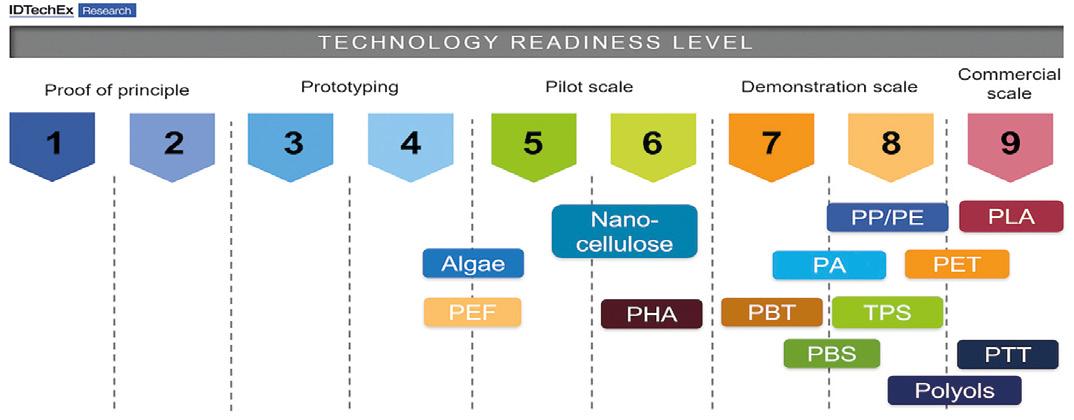
packaging trends italian food & packaging technology - cii (2022) - november 31
www.idtechex.com
Aseptic packaging demand to grow 5.5% annually
A new Freedonia Group analysis forecasts de mand for aseptic packaging for food to increase 5.5% annually to $2.3 billion in 2026. Aseptic processing will increasingly be preferred over more traditional thermal processing methods such as retort and hot fill due primarily to its shorter heating times, which better maintains the flavor, texture, and nutrition of food that these other processing methods.
Strong gains in aseptic packaging demand
Through 2026, aseptic packaging will continue to see strong demand growth in the packaging of milk and milk alternatives, soups, tomato products, and other foods. However, growth will lag significantly in the juice market – the largest application of aseptic packaging – due to market maturity and a declining interest in the overall ambient juice category, which
faces intense competition from fresh and coldpressed juices and other lower sugar beverages.
Aseptic cartons remain most popular

Aseptic cartons account for the largest share of aseptic packaging, and they are increasingly taking share from traditional shelf stable packaging such as cans in applications such as soups, stocks, broths, and sauces. The advantages aseptic cartons offer over cans include their lower weight, more modern aesthetic, and greater shelf appeal. However, the higher cost of these prod ucts and issues surrounding their recyclability will re strain even further penetration into these applications.
Sustainability remains a key innovation driver
Sustainability remains a key issue in the packaging industry as a whole and especially for aseptic packag ing. The composite material used in the manufacturing of cartons and pouches to extend shelf life is difficult to recycle in practice due to lack of adequate recycling infrastructure and difficulty in separating the materials. However, aseptic packaging producers are addressing this by focusing on material improvements. Carton pro ducers are eliminating the aluminum barrier layer typi cally found in aseptic cartons to increase their recycla bility, while monomaterial pouches are being developed that are still compatible with aseptic filling.
Aseptic Food Packaging provides historical data (2011, 2016, and 2021) and forecasts for 2026 for aseptic food packaging demand for in current dollars (including infla tion) by product, application, and material.
www.freedoniagroup.com
packaging trends 32 italian food & packaging technology - cii (2022) - november



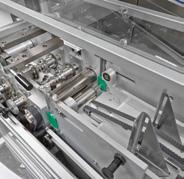



Capsules growth is slowing down and competition intensifies in aluminium
AMI has published its 4th report mapping the glob al Single Serve Capsules industry. The report aims to support the development of robust participation strategies by equipping industry players and investors with a comprehensive understanding of scale of po tential for future development, growth dynamics per system, market drivers and competitive pressures.
Over 80 billion capsules were filled in 2022 global ly, both aluminium and plastic formats. Single serve capsules are a dynamic market segment with a com plex value chain. The changes in this industry are fast, and driven by growing sustainability pressures and end-of-life scenarios, brand positioning as well as organic consumption trends.
The context of 2020-2021 pandemic lockdowns boosted the demand for single serve capsules in Eu rope and North America. Both retail and online sales of capsules sharply increased, anecdotal industry feed back being 30-50% growth in lockdowns. Operationally, throughout the first 2 lockdowns filling was working at near capacity and in shifts to assure safety of per sonnel. Some SKUs were sold out, which was to do with prioritisation of lines and optimal operations to limit changeover times. The second half of 2021 and 2022 resembled more of a normal sales pattern, and the spikes in consumption had settled down. The growth is now largely slowing down. Unlike previously, there was a significant volume increase for original capsules between 2020 and 2022. Nestlé has been managing its portfolio of products extremely well - increasing sales of Nespresso via the Starbucks brand, which was pop ular in conventional retail. Still, the share of compatible capsules is rising. The Nespresso compatibles include both private label (retailer own brand) and branded of fering (L’Or, Café Royal, Dallmayr Capsa).
Penetration of compatible single serve capsules in 2022 (AMI).

The compatibles’ need for differentiation result ed in capsule material and barrier spec adjustments, impacting positioning. To this end, L’Or was success fully relaunched in aluminium capsules in 2017. Given L’Or’s aluminium victory, post 2018 the market had gone through the process of dramatic transition from plastic to aluminium Nespresso compatibles.
The growth of aluminium was a result of both the organic growth of consumption of Nespresso and Nes presso compatible capsules buoyed by system ration alisation, but also by inter-material substitution trend away from high barrier plastics in particular. As previ ously experienced with plastic Nespresso compatibles, there is a current need for differentiation of aluminium compatibles. This can be delivered with aesthetics – not only a variety of lacquers, but also embossing, design features, pre-printed patterns, etc.
The aluminium opportunity had beckoned new entrants and the competition has intensified.
www.ami.international
packaging trends 34 italian food & packaging technology - cii (2022) - november
VTT develops transparent cellulose film to replace traditional plastic
Food packages fulfil their most important tasks when they protect food and minimise waste. Thin plastic films are nevertheless difficult to recycle, and they often end up in the wrong places after use.
VTT has developed a solution to the problem of plastic packaging. Regenerated or recrystallised cellulose can replace plastic films. “We can produce transparent and flexible cellulose film. The consum er cannot distinguish between the crystal-clear ma terial and traditional oil-based plastic. Cellulose film can resist dampness, but in nature it disappears as completely as a sheet of paper does. The product is biobased and biodegradable”, says VTT Research Professor Ali Harlin.
In addition to their protective properties, plastics are important because consumers want packages that allow them to see the product itself. Howev er, once they have been used, many packages are sources of problems. If a package has both paper and plastic, the consumer may wonder if it can be recycled with cardboard, or if the plastic needs to be torn off first. Some of the materials have alter nating layers of fibre and plastic. Many packages are placed among mixed waste by people who cannot think of a better way of dis posing of it. Plastic that ends up in a cardboard recycling bin can be removed, but the plas tic usually ends up incinerated.
“The cellulose film devel oped by VTT can replace plas tic as a more climate-friendly solution. It also makes recy cling easy, as it can be placed in cardboard recycling along with other packages”, says Atte Virtanen, Vice President, for Biomaterial processing and products at VTT. Finland re mains far from the goals set by the EU for reducing the environmental harm caused by plastics. At present about 20% of plastics are collected, and even less ends up recy
cled. Under the EU target, 55% of plastics should be recycled by 2025.
Plastic film market worth 110 billion dollars
Finland is currently more of a packaging material country than a printing paper country. Last year the value of sales of cardboard exceeded that of paper for the first time. The forest industry is looking for new products with a big market, which bring val ue-added. Flexible, transparent cellulose film is one such product. The world market for plastic films was about 110 billion dollars last year.
VTT’s unique expertise has been used in cel lulose film as a replacement for plastic. “VTT has researched cellulose films for more than ten years, and for more than six years on regenerated cellu lose in transparent films”, Virtanen says.
The production of packaging material is in the pilot phase, and it could be in extensive industrial use in 5–7 years.

packaging trends italian food & packaging technology - cii (2022) - november 35
www.vtt.fi
Researchers develop plastic film that can kill viruses using room lights
Researchers at Queen’s University Belfast have developed a ground-breaking plastic film that can kill viruses that land on its surface with room light. The self-sterilising film is the first of its kind – it is low cost to produce, can be readily scaled and could be used for disposable aprons, tablecloths, and curtains in hospitals. It is coated with a thin layer of particles that absorb UV light and produce reactive oxygen species – ROS. These kill viruses, including SARS2.
The technology used to create the film also en sures it is degradable - unlike the current disposable plastic films it would replace, which is much more envi ronmentally friendly.
The breakthrough could lead to a significant re duction in the transmission of viruses in healthcare environments but also in other settings that uses plastic films – for example, food production factories.
The Queen’s researchers tested the film for an ti-viral activity using four different viruses – two strains of influenza A virus, a highly-stable picorna virus called EMCV and SARS2 – exposing it to either UVA radiation or with light from a cool white light flu orescent lamp. They found that the film is effective at killing all of the viruses - even in a room lit with just white fluorescent tubes.
The research, which has been published in the Journal of Photochemistry and Photobiology B: Biology, was carried out by Professor Andrew Mills, Dr Ri Han and Dr Christopher O’Rourke in the School of Chemistry and Chemical Engineering at Queen’s University Belfast and Dr Connor Bamford and Dr Jonathon D. Coey at the Wellcome-Wolfson Institute for Experimental Medicine in the School of Medicine, Dentistry and Biomedical Sciences at Queen’s.
Professor Andrew Mills comments: “This film could replace many of the disposable plastic films used in the healthcare industry as it has the added value of being self-sterilising at no real extra cost. Through rigorous testing we have found that it is effective at killing viruses with just room light – this is the first time that anything like this has been developed and we hope that it will be a huge benefit to society.”
Dr Connor Bamford says: “Pathogenic viruses like SARS2 and influenza will continue to be global prob lem for years to come. In developing self-sterilising thin plastic films, we have created a low-cost tech
nology that could have a significant impact on the transmission of such concerning viruses in a health care environment and other sectors where they are used.” The project was funded by the Engineering and Physical Research Council, which is part of UK Research and Innovation.
EPSRC Director for Cross Council Programmes, Dr Kedar Pandya, comments: “This is a hugely exciting development which has the potential to dramatically reduce the transmission of viruses across a wide range of settings while being environmentally sustainable.
“It is an excellent example of adventurous, innova tive research which has the potential to improve the lives of millions of people.”
The microperforated packaging design for fresh-sliced mushrooms
Fresh mushrooms have a very short shelf life, of 1-3 days because of their high respiration rate and lack of cuticles that protect the plant from external factors. In the case of fresh-sliced mushrooms, they will be more susceptible to spoilage reactions due to the increase in respiration rate as a result of a broad er surface area. Conventional packaging materials

packaging trends 36 italian food & packaging technology - cii (2022) - november
cannot meet the requirements for modified atmos phere packaging of fresh-sliced mushrooms.




One of the techniques to extend the fresh-cut produce shelf life is the passive modification of modi fied atmosphere packaging technology. For highly re spiring fresh-cut produce such as fresh-sliced mush rooms, the permeability properties of the polymeric materials might not be enough to provide an equi librium gas concentration in the passive modification of modified atmosphere technology. In this case, the microperforated packaging materials can be used for passive modification of fresh-cut produce. But the microperforation process needs a design for the application of the appropriate number and diameter of microholes to meet the requirements of passive modified atmosphere packaging.
For this reason in a Turkish research published in Potravinarstvo Slovak Journal of Food Sciences, the






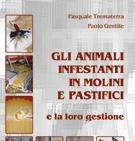













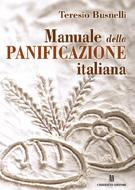













design of the microperforation process to be used in passive modified atmosphere packaging was based on the diameter and the number of microholes, and the shelf life of fresh-sliced mushrooms was deter mined. The samples were stored at 15degreeC/80% RH, and pH, color, weight loss, textural, sensorial, and microbial analysis were performed periodically during storage. It was determined that the empiri cal equation used in this research can be applied to microperforated packaging design for fresh-sliced mushrooms. The shelf life of the fresh-sliced mush rooms packaged with microperforated packaging material was 8 days, while it was less than 7 days (4, 5, or 6 days) when packaged with non-microperforat ed packaging material.


This result shows that the use of microperforated packaging material is effective in extending the shelf life of fresh-sliced mushrooms.

packaging trends italian food & packaging technology - cii (2022) - november 37
shop.chiriottieditori.com RIEMPITIVO LIBRI 2018 1-2_new.indd 2 16/05/18 11:19
PACKAGING EQUIPMENT
Flexible automation solution for cardboard packaging
The long-established Balocco S.p.A. confectionery company based in Piedmont, Italy, has opted for sustainable FSC® cardboard boxes to package its new ZeroPiù Balocco biscuits. With the Multipacker from Schubert, the company has invested in a flexible packaging system for flowpacks and cartons that can process both paper and plastic.

For three generations, Ba locco has been dedicated to sweetening the lives of millions of consumers around the world. The Balocco family’s passion for sweets dates back to 1927, when Francesco Antonio opened his first confectionery shop in
Fossano, located in the heart of Piedmont. Today, with produc tion and logistics facilities cov ering 75,000 square metres, the company is the second largest player in the domestic market for breakfast biscuits and seasonal cakes such as Panettone or Pan doro for Christmas and Colomba for Easter.
In 2010, the company em barked on an ambitious invest ment plan with new technologies to improve its environmental per formance. The Fossano site and the logistics centre in Trinità are equipped with photovoltaic sys tems that generate some of the electricity consumed, while the rest comes from other renewable
The Multipacker from Schubert carries out the primary packaging of the biscuits into flowpacks, as well as the secondary packaging into cartons or optionally into multipack flowpacks.
38 italian food & packaging technology - cii (2022) - november
Square, round or oval
The Flowpacker is designed to handle different product formats with great flexibility. The fact that the biscuits are square, round and oval doesn’t pose a problem for the machine. And a programme change takes only a few minutes. The integrated image recognition system, consisting of three reflect ed-light scanners, not only detects the position and orientation of the products, but also ensures that only flawless products are packaged. In the event of delays on downstream equipment, the feeding of the biscuits can be buff ered for four minutes to ensure that the packaging process runs as
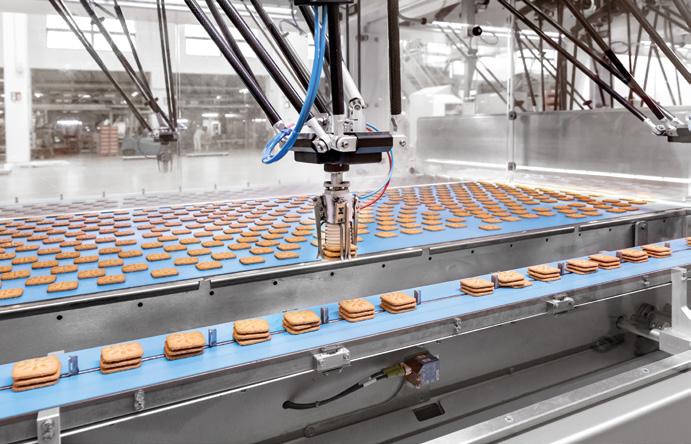
sources. Now, the company aims to significantly reduce the use of plastic in biscuit packaging by replacing plastic flowpacks with recyclable paper packaging wher ever possible.
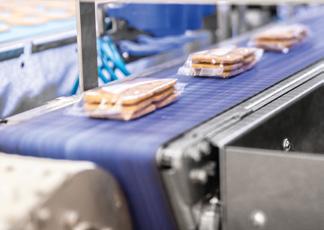
Flexible sealing technology for both plastic and paper
Since August 2021, with the Schubert Multipacker consisting of a Flowpacker and Cartonpack er, Balocco has been taking ad vantage of a packaging solution that flexibly enables this change over. The packaging machine’s flexibility was integrated into its design right from the word go: The sealing technology, product formats and packaging materials can all be changed over from the variants used to date to the most innovative solutions – and all with quick format changes. The rapid response time makes this pack aging machine an exceptionally future-proof and cost-effective investment.
An ultrasonic longitudinal sealing unit and flying cross-seal ing unit, with their constant seal ing times accurate to the millisec ond, seal the plastic films quickly and reliably. They also guarantee that paper-based films can be processed in the future with im peccable quality.

packaging equipment italian food & packaging technology - cii (2022) - november 39
Twenty T4 robots guarantee outstanding performance and gentle picking of the products, which are then passed on to the two integrated Flowmoduls.
Balocco opted to use sustainable FSC® cardboard boxes to package its new ZeroPiú shortbread biscuits.
smoothly and quickly as possible. Twenty T4 robots guarantee out standing performance and gentle picking of the products, which are then passed on to the two inte grated Flowmoduls. The grippers were specifically developed for the customer’s diverse assortment of baked goods: They gather the biscuits into stacks, which are then placed into the Flowmodul’s feed chains. The system also boasts Schubert’s well-known flexibility when it comes to flowpack sizes, box formats and cartons.
Downstream of the Flowpack er, a Cartonpacker takes over the packaging of the flowpacks into boxes. In six frames for erecting, filling and sealing, the automated process runs in sync with the up stream machines. Five pick & place robots pick up the flowpacks and stack them onto the Transmodul for pre-grouping, after which they are placed into the cartons and sealed. Alternatively, the Multipack er can erect open carton trays, fill them and then pack them directly into multipack flowpacks with the aid of the integrated Flowpacker.
In addition to its high perfor mance, the entire system excels with exceptionally compact de sign, which enables considerable space savings: The flow-wrapping machine saves up to 70 per cent space compared to conventional machine solutions. With the Mul tipacker, Balocco can now adapt much more flexibly and sustain ably to the needs of consumers and retailers, and thereby benefit from new market opportunities and competitive advantages.
(Gerhard Schubert GmbH - In dustriegebiet Südost - Hofäckers traße 7 - 74564 Crailsheim - Germany - Tel. +49 7951400-0 - e-mail: info@gerhard-schubert. de - www.schubert.group)
Monobloc case packer with pick & place system
The increasing attention to the market needs makes it nec essary to search for innovative technical solutions allowing to reduce costs, save energy, increase competitiveness and improve the market position ing.
Every day in the world billions of doses of beverages, food and hygiene and cleaning products are consumed. They are market ed in containers with thousand shapes and countless features, that need adequate protection during handling and captivating look in order to draw consumers’ attention.
For this reason, packaging is a key factor to be taken into account in business strategies aimed at boosting sales.
SMI offers cutting-edge solu tions inspired by the concepts of Industry 4.0 and Internet of Things (IoT) that are increasingly efficient, flexible, eco-friendly, ergonomic, easy to control and to check.
Cardboard boxes are an ex ample of packaging with a simple but effective design, optimized depending on the size of the product to be packed and ideal for maximizing the visibility of the pack on retail shelves thanks to the possibility of graphic cus tomization.
With the launch of the new range of automatic case packers with pick & place system of the ACP (American Carton Packer) ERGON range, SMI got into the packaging in RSC cases, thus providing customers with a valid alternative to traditional pack
aging solutions in wrap-around cardboard cases.
The choice between a wraparound box and an RSC case de pends on several factors related to the product to be packaged, to commercial strategies, to logistics and distribution needs and to the speed of the pro duction line. Other factors that have to be taken into account are for instance the weight and the shape of containers, the pal letizing patterns, the marketing objectives, the budget available and the need or not to display the package on the shelves of retail points.
At all4pack 2022, that will be held from 21st to 24th November in Paris (France), SMI will show case the ACP 20 S ERGON. The solution showcased at stand F043 Hall 4 pack glass bottles of beer in 4x3 format in RSC cases that are closed by scotch at the speed of 20 packs/minute.
The advantages of ACP series
Compactness and ergonomics
The new ACP case packers fea ture a solid monobloc structure that combines all the machine functions: product separation, product insertion with top load ing system, carton magazine, box sealing.
The packaging process is al ternate (stop & go) by means of a pick & place system capable of making RSC packs at the maxi mum speed of 20 packs per min ute (depending on the format).
packaging equipment 40 italian food & packaging technology - cii (2022) - november
Versatility of use and product protection
ACP range can pack several types of products, such as bags of pasta, rice and coffee, as well as oval containers (shampoo, liquid soap and detergents) and briks (tea, juices), simply by changing the gripper/suction cup.
Thanks to the pick & place system, the new SMI case pack ers are suitable for packing very delicate and exclusive products, such as wines, sparkling wines and liqueurs, without damaging the label of glass bottles during processing in the machine.
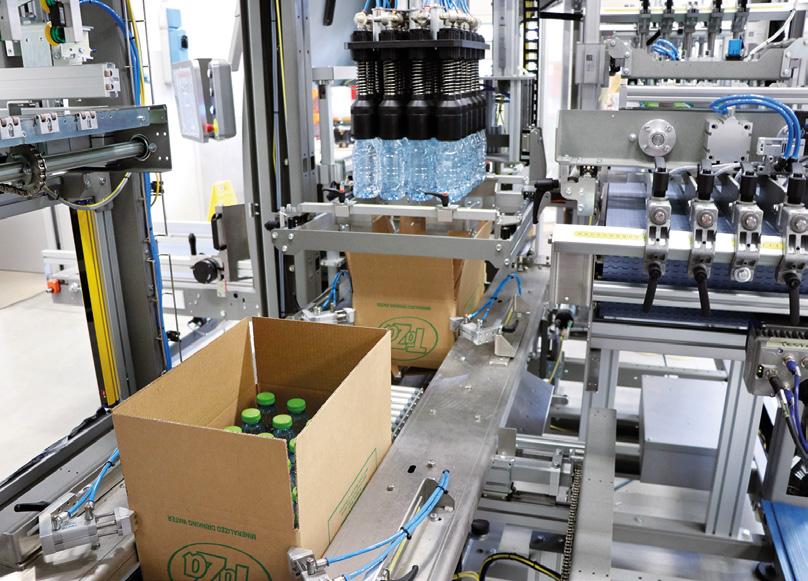
Thanks to the extreme versa tility of ACP series, the products to be packed can also be stacked inside RSC boxes, that, further more, are very robust and resist ant (high top load).
Ease of use and advanced automation
The carton magazine is placed next to the machine, thus allow ing to load the pre-folded blanks in an easy and ergonomic way.
The new SMI pick & place pack ers are equipped with MotorNet System® automation and control technology, based on Sercos fieldbus, that makes the plant fully compliant with Industry 4.0 and Internet of Things (IoT) prin ciples.
The ACP ERGON models are available in two versions: with tape sealing (ACP S) or hot melt glue sealing (ACP G).
Technical features of ACP ERGON series
• Alternate packaging process (stop & go) through pick & place system capable of making pack ages at the maximum speed of 20 packs/minute (depending on the format)
• Grouping of products in an alternating cycle, through a pneumatic separation system;
• Carton magazine placed next to the machine with easy and ergonomic loading of the pre-folded blanks;
• Packaging in American style cardboard boxes (RSC) with loose product top loading;
• Possibility of stacking the product in the box during its insertion;
• Possibility of packaging several types of products, such as bags of pasta, rice, coffee, as well as oval containers (such as shampoo) and briks (tea, juices, etc), simply by changing the picking gripper;
• Possibility of processing deli cate products, such as wines, sparkling wines and liqueurs, without damaging the label dur ing processing in the machine;
• Easy machine access
• Reduced mechanical wear and maintenance
• MotorNet System® automation and control technology based on Sercos fieldbus
• Depending on the model chosen, the box is closed by means of adhesive tape or hot glue. The model with glue pack closure is equipped with a lower glue unit and an upper glue unit with double spray that ensure excellent pack sealing. At the machine outfeed, special lateral upper flap-folding devices driven by a semi-rotary cylinder keep the walls of the newly made box pressed.
(SMI S.p.A. - Via Carlo Ceresa 10 - 24015 San Giovanni BiancoBG - Italy - email: info@smigroup. it - www.smigroup.it)
packaging equipment italian food & packaging technology - cii (2022) - november 41
Monobloc case packer with pick & place system for RSC boxes at the All4pack 2022 show (SMI)
P.E. Labellers at Simei: labelling innovation for Wine & Spirits
P.E. Labellers has been work ing in the wine & spirits industry for almost 50 years, gaining cus tomers all over the world thanks to its ability to adapt labeling machines to the new production requirements of companies and to the increasingly high-quality standards imposed by the market.
P.E. solutions for wine and spirits show such versatility that they are ideal for labeling glass or plastic bottles and cans, of different formats and sizes, at different speeds and based on different labeling technologies. In a word, total flexibility.
Simei in Milan is a must-at tend showcase, and in this 2022 edition P.E. is displaying the best of its solutions designed for wine producers and bottling compa nies in the supply chain.
What’s on display at Simei?
At the amazing, customized booth of P.E. Labellers (hall 2P, booth E11-F20) you can find the best labeling solutions for wine & spirits:
MODULAR SL, the multi-con figuration and multi-technol ogy labeling machine, fully equipped with all new labeling stations and special solutions:

• new FA-ST 140 m/min units
• 6 pressure sensitive labeling stations
• the units work in non-stop mode
• optical orientation system
• capsule presence control de vice
• bottle fall control device
NEW SPINNER, the new linear machine by PackLab, the divi sion of P.E. Labellers special izing in labeling solutions with pressure sensitive technology. The new Spinner is the latest creation by PackLab division, with specific features for Wine
Modular SL 1730 labeling machine (P.E. Labellers).
SLK module for pressure sensitive labeling (P.E. Labellers).

& Spirits sector, previewed at SIMEI 2022.
P.E. Labellers is confirmed as a world leader in labeling solu tions, for all applications in Wine & Spirits and in every Packaging industry: Beverage, Food & Diary, Personal & Home Care, Chemicals, Pharmaceuticals, Pet Food.
(P.E. Labellers - Via Industria 56 - 46047 Porto MantovanoMN - Italy - Tel. +39 0376389311 - email: pelabellers@pelabellers. it - www.pelabellers.it)

packaging equipment 42 italian food & packaging technology - cii (2022) - november
P.E. Labellers headquarter.



Influence of room layout on airflow distribution in an industrial fruit store
Fruit and vegetables are stored for up to several months in large bin stacks in refrigerated rooms. Gaps between the bins and bin wall openings should al low the circulation of cooling air to remove field and respiration heat from produce.

In an industrial apple store, the effects of the stacking array, fan position and number on airflow distribution in vertical gaps and inside plastic bins were investi gated by German Researchers using stepwise reduction of fan revolution and the results were published in the International Journal of Refrigeration
probably due to additional flow paths in the horizontal gaps. The lowest air speed was measured when bins were stacked in one block without vertical gaps and a distance to the side walls of only 10 cm. A stacking arrangement with only one central vertical gap
between four bin rows or with a large distance (>1 m) between the wall opposite to the fans and the bins enhanced flow uniform ity. Three fans situated above the vertical gaps was more effective for the ventilation of bins than four fans above the bin rows.
Automatic tray sealing machine
The PUMA automatic tray sealing machine is the first in line model of I.Dea Pack’s fully automated machines. The PUMA enables huge productivity in crease due to its reliability, ease of cleaning / maintaining and simplified operating programs and die set changeover, that are just some of its strengths.
This machine has a stainless steel structure and features ATM-MAP, Skin and Skin on car doboard with the same mold. Its main accessories are: destacker, dispenser, automatic weigher, printer, photocell for the printed film, filter for powders or liquids, aluminum tray closure, align er at the outlet, independent motorization of the belt, vac uum pump above 100 m3/h. A version for trays with higher
At 100% fan power, the aver age air velocity in vertical gaps between bin rows in the main flow direction increased with reducing total cross section of the gaps. In contrast, the number of vertical gaps between bin rows had little effect on the average air speed between fruit inside the bins,
PUMA automatic tray sealing machine (I.Dea Pack).

heights (max 120 mm) is also available.
The PUMA increases also products’ quality with its strict control of gases remaining within the tray, due to an accurate elec tronic sensor, and with its com pliance to European Community Regulation 1935/2004/EC, that defines the requirements for ma terials and articles intended into contact with food.
(I.Dea Pack - Via G. Falcone 5325035 Ospitaletto - BS - Italy - Tel +39 030 6857311 - email: info@ ideapack.info - www.ideapack. info)
packaging equipment 44 italian food & packaging technology - cii (2022) - november
































































































































































































































































































































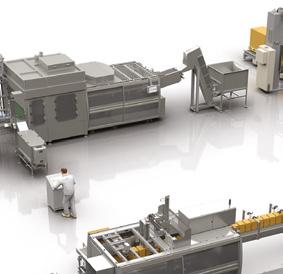



SKIN packaging technology



The Coligroup packaging ma chinery range includes: vacuum chamber machines, flowpack combined systems, traysealing machines and the thermoform ing machines, which are the Coligroup’s core business. Labe ling, printing & dosing systems together with the most modern robotic feeding applications are optional. These make packaging systems complete, efficient and unique. All Colimatic machines are designed and exclusively per sonalized according to the cus tomers exact requirements.
WEB SKIN is the solution to obtain a recyclable and ecological package without compromise on the cost of the product to the final consumer.

The WEBSKIN packaging pro cess combines the indisputable economic, productive and hygienic advantages of the packaging pro cess that uses in-line thermoform ing (thermoforming machine) with the pleasant appearance of the pack made using preformed trays (tray sealer) while significantly re ducing the use of plastic. This pre printed pack with customizable graphics, is made from a reel thus eliminating the storage and man agement costs of pre-cut sheets.
Special cutting station, devel oped for the biomedical sector, allows a perfect cut of the pack age reducing to zero the possi bility of release of contamination with cardboard fibers. Special Skin system up to 50mm protru sion on cardboard.
Cardboard base with a spe cial registration system, real ized through a revolutionary algorithm, guarantees forming, sealing, cutting and printing operations are perfectly syn chronized.

SKIN packaging technology produces a vacuum pack that pro tects the product and fits around it like a second skin. THERA ther moforming line creates a rigid bottom support to be sealed with top film in order to produce vacu um pack. The maximum shelf-life is guaranteed while the product shape is well maintained without any liquid leakage.
(Colimatic - Via del lavora A 9 - 25032 Chiari - BS - ltaly - Tel +39 030 7000761 - email: info@ colimatic.it www.colimatic.com)

packaging equipment 46 italian food & packaging technology - cii (2022) - november
THERA thermoforming line with SKIN packaging technology (Colimatic).
+ NEWS + INFORMATION www.foodexecutive.com FOODEXECUTIVE 1-4.indd 4 31/03/21 16:32
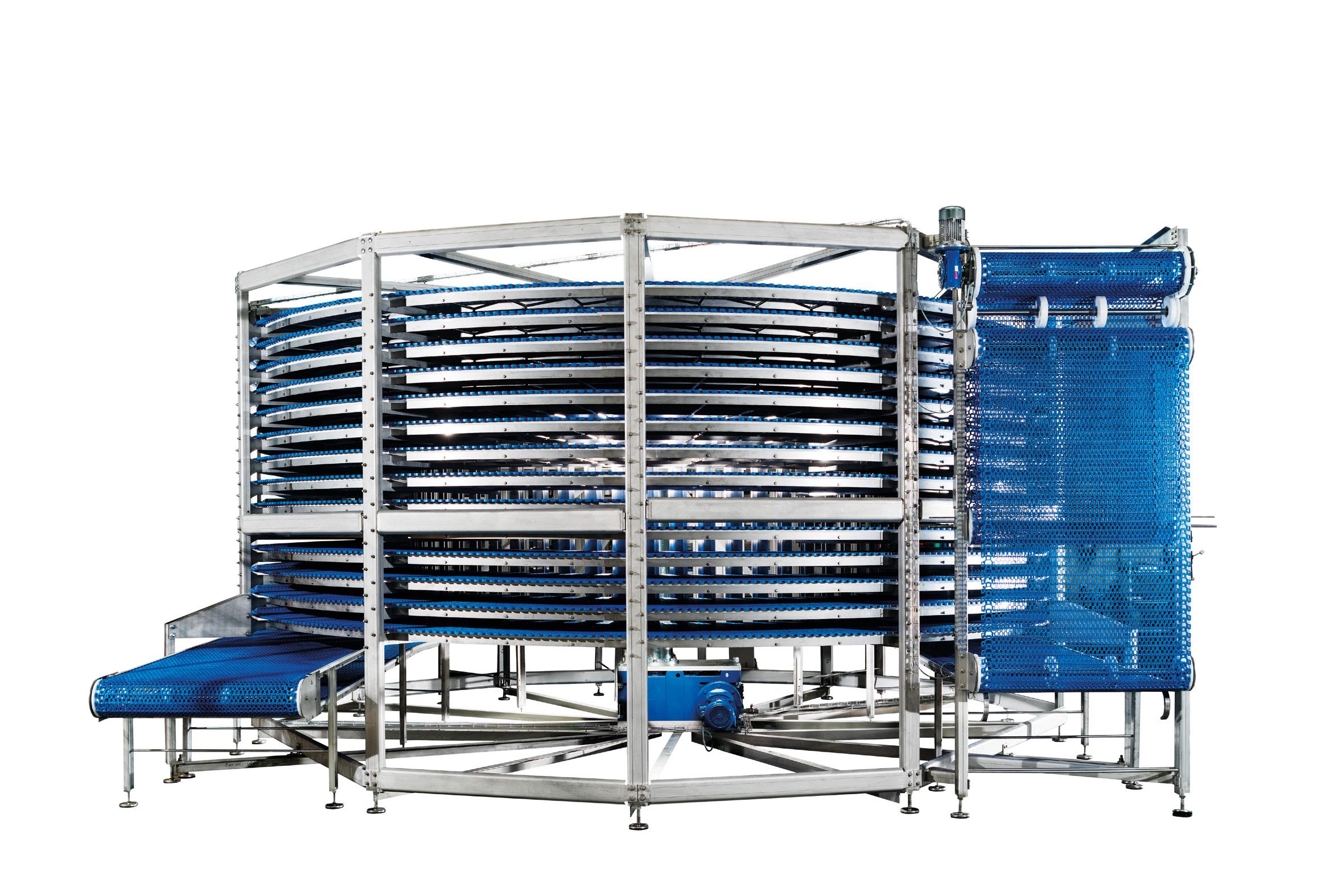



WWW.SARP.IT COOLING LINE FOR PIZZA CRUST BAKERY DIVISION BAKERY PROCESSING BY SARP Food processing We have chosen to deal with food technologies with passionandwewanttoshowyouour INNOVATIVE TAILOR-MADE linesandmachines. Weprojectuniquesolutionsthatcan fit the needs of everyone. SPIRALS WITH LATERAL DRIVE SYSTEM, DRUM SPIRALS, AIR OR WATER, COOLING, FREEZING, PASTEURING, DIFFERENT SHAPES, ... WE HAVE NO LIMITS FOR OUR CREATIONS!
NUTRITION
Making butter-like spreads healthier
A dollop of margarine or spread can go a long way to liv ening up a slice of toast, a piping hot ear of corn or other food. But that enhanced flavor can also come with a side helping of worry over consuming saturated
fats, which are used as solidifying agents in some margarines and spreads and give them their but ter-like properties.

Jill Moser and Hong-Sik Hwang, research chemists with the Agricultural Research Ser
vice (ARS) in Peoria, Illinois, Usa, want to create a healthier prod uct by replacing those fats with plant-based and other natural waxes-sunflower, rice bran, can delilla and beeswax, among them. They do this by melting the wax es in hot vegetable oil and letting it cool to room temperature. This results in a semi-solid substance called an oleogel. When mixed with water, salt and other ingredients, the oleogel mimics the role of saturated fat in producing a margarine, spread or shorten ing that has the desired firmness, mouthfeel, melting point, shelflife and other properties, includ ing when used in baked goods.
Researchers are replacing saturated fat with sunflower, rice bran, candelilla and other natural waxes to create healthier margarines and spreads for consumers.
Artificial trans fats (those not naturally present in meat and dairy products but rather created via a chemical process called par tial hydrogenation) were once the popular choice for making mar garines, spreads and shortening. However, artificial trans fats were phased out of use in 2021 over concerns their consumption can increase the risk of heart dis
48 italian food & packaging technology - cii (2022) - november
ease and stroke. Saturated fats without a trans structure, such as from palm oil and fully hydro genated vegetable oil, are among the replacements now used to make margarine, spreads and shortening. Consumers, though, are advised to limit their intake of saturated fats from foods or beverages that contain them.
Using wax-based oleogels, “we think 100% of the saturated fats can be replaced, including saturated fat in palm oil and fully hydrogenated vegetable oil,” said Hwang, who, together with Mos er, is located at the ARS center’s Functional Foods Research Unit in Peoria.
The wax-based oleogels are made of a network of plate-like crystals that immobilize mol ecules of oil in a gel state that mimics the function of solid saturated fat in margarines and spreads-minus the associated human-health concerns.
To date, the researchers have created oleogel formulations from four different natural waxes and 12 different kinds of vegetable oils, including soy and, most recently, hemp seed oil, which is rich in ben eficial polyunsaturated fats and antioxidants, including Vitamin E.
Of the waxes they’ve worked with, sunflower and rice bran seem to work best in creating margarines and spreads that compare to those made from fully hydrogenated (saturated) vegetable oil. Very little wax is needed, too. In one experiment, between 2 and 6 percent of sun flower wax was needed to create an oleogel that was nearly as firm as margarine containing 18 to 30 percent of saturated soy oil.
Oleogel ingredients can come from a variety of sources, but those derived from plant waxes
are especially of interest because they are “generally recognized as safe” by the U.S. Food and Drug Administration and are abundant and inexpensive. Sunflower wax es, for example, are waste prod ucts generated from refinery procedures used to remove impu rities from crude oil in the flow ering crop’s seed. Similarly, rice bran waxes are waste byproducts of husk-oil refining methods.
The researchers continue to refine the oleogel formulations,
for example, by blending different waxes with oils to achieve the very best combination of prop erties expected in a margarine or spread. Their efforts and collabo ration with industry are part of a larger research effort at the ARS center to usher in new, value-add ed uses for both established crops such as corn and soybeans and newer ones such as penny cress and hemp that will benefit pro ducers and consumers alike.
www.ars.usda.gov
Quinoa sourdough-based biscuits with high antioxidant activity

Argentinian Researchers have evaluated the capacity of au tochthonous lactic acid bacteria (LAB) (43) from Andean grains to increase the antioxidant ac tivity (AOA) and total phenolic compounds (TPCs) in quinoa sour dough to select best performing strains to be used as starter cul tures in the elaboration of biscuits.
Microbial growth (CFU per g) and pH were evaluated dur ing quinoa dough fermentation. Counts were increased in a range of 0.61-2.97 log CFU per g and pH values between 3.95 and 4.54
were determined after 24 h at 30°C of fermentation. Methanolic (ME) and aqueous (AE) extracts were obtained at the end of fer mentation, and free radical scav enging capacity was performed by the DPPH and ABTS methods. ME was selected for further analysis using other methods and TPC quantification. Principal component analysis showed the highest scores of growth, acid ification capacity, AOA and TPC for the strains Lc Mesenteroides subsp. mesenteroides CRL 2131 and L. plantarum CRL 1964 and CRL 1973. AOA and TPC in biscuits made with sourdough from these LAB were higher than the acidified and uninoculated controls.
According to the results pub lished in the Journal of Applied Microbiology, autochthonous LAB strains (3) increased the AOA of quinoa-based biscuits and quinoa sourdough obtained with selected LAB is suitable as an ingredient for bakery foods with improved antioxidant status.
italian food & packaging technology - cii (2022) - november 49 nutrition
Canola and olive oil gelled emulsions as fat replacers in beef burgers
To meet the consumer de mand for a healthier diet, Brazilian Researchers tested the feasibility of using vegetable oil gelled emul sions in low-fat industrialized burgers with high contents of pol yunsaturated fatty acids (PUFAS).
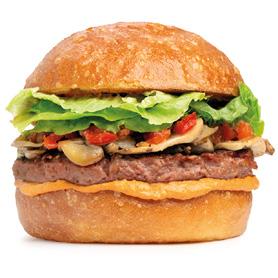
Commercial canola and olive oils have been tested as a rel atively inexpensive source of PUFAS. Beef burgers were refor mulated by replacing (0, 25, 50, 75 and 100%) pork back-fat with two carrageenan gelled emulsions of vegetable oils (canola and olive oil). The technological character istics, sensorial properties and the fatty acid profile of reformulated burgers were evaluated.
Moisture content and cooking loss increased and fat and pro tein contents reduced with higher replacements. Oxidative stability was not affected and replace ments of up to 75% did not affect the burger’s acceptance. A total fat content reduction of 40% was achieved in burgers with 100% back-fat replacement, improving its nutrient value by increasing the omega-6/ omega-3 ratio and decreasing the saturated fatty acids content (in 47%) and the atherogenic (from 0.61 to 0.22) and thrombogenic (from 1.29 to 0.65) indexes. Replacing up to 75% with canola oil gelled emulsion is a promising approach in the de sign of healthier industrial low-fat burgers.
Due to the association of some diseases with the con sumption of products rich in sat urated fat, the industry looks for alternatives not only to reduce the fat content but also to mod
ify the fatty acid profile in meat products. This study, published in the British Food Journal, further confirms the possibility of using carrageenan gelled fat replacer in industrialized burgers formulat ed with meat and other ingredi ents/additives commonly used to provide economic benefit. Also, confirms the feasibility to use
commercial vegetable oils with relatively cheap cost than ome ga-3 rich oils as the oil phase in the gelled emulsion.
Cistus ladanifer seeds: from ancient snack to novel and sustainable food ingredient
Cistus ladanifer is a persistent, abundant and widespread under explored resource in the Iberian Peninsula. The seeds have been used as food for centuries, al though their nutritional value and potential as food ingredients have not been exploited until now.

In a study published in the Journal of Food Composition and Analysis by Portuguese Re searchers, seeds from natural shrubland were collected three
times during summer for two consecutive years. Analytical evaluation of the macronutrient content, fatty acids, and miner al composition was performed. Regarding the macronutrients, seeds showed a carbohydrate content of 46.1 ± 1.6%, a fibre content of 20.9 ± 1.4%, a pro tein content of 16.2 ± 0.4%, a lipid content of 13.0 ± 1.1%, and an ash content of 3.87 ± 0.16%. The fatty acids were found to be mostly unsaturated (74.05 ± 0.59%). Potassium was the most abundant mineral (975 ± 53 mg/100 g) followed by phospho rous, magnesium and calcium. In conclusion, several nutrient-re lated label claims may be used for C. ladanifer seeds as food ingredient. Compared to common cereals, nuts and seeds, C. ladani fer seeds are close to flax and chia seeds in relation to nutritional composition, and to pine nuts in relation to mineral composition.
50 italian food & packaging technology - cii (2022) - november nutrition
Bread as probiotic carriers
A study carried out by Brazil ian Researchers evaluated the resistance of Bacillus coagulans GBI-30,6086 (BC) spores through the processing and storage of white and whole wheat bread. The physicochemical parame ters of the probiotic bread formu lations were also characterized. Loaves of bread containing or not BC were prepared. Throughout the processing, samples were collected (after mixture, after fer mentation, and after baking) for enumeration of BC. In addition, BC was enumerated in different parts of loaves of bread (crust, crumb, and whole slice) collect ed after baking (day zero) and at different storage times (3, 7,
and 10 days). The incorporation of BC did not affect the moisture, specific volume, texture and color parameters, water activity, and pH of loaves of bread. Mixing and fermentation steps did not reduce the BC survival in white or whole wheat bread. The high est (p < 0.05) number of decimal reductions (gamma) was caused by baking in the crust for both loaves of bread. Baking caused around two gamma of BC in the crust and 1.5 gamma of BC in crumb and a whole slice of white and whole bread. Generally, stor age did not increase the gamma caused by baking, regardless of the evaluated part or type of bread. Results published in Food
Research International journal show the impacts of baking on BC and highlight the formulated white and whole wheat loaves of bread as suitable carriers for de livering the probiotic BC.

Oral processing behaviours and taste intensity
The aim of a study published in Food & Function journal was to understand the influence of saltiness and sweetness intensi ty on oral processing behaviours

of liquid, solid and composite foods.
As salty foods, tomato sauce (liquid), penne pasta (solid) and their combination (composite
food) were used at two levels of saltiness intensity (low/high). As sweet foods, strawberry sauce (liquid), milk gels (solid) and their combination (composite foods) were used at two levels of sweet ness intensity (low/high). Salti ness, sweetness, hardness, chew iness, and liking were quantified using generalized labelled magni tude scales (gLMS). Oral process ing behaviours were determined using video recordings (n = 39, mean age 25 ± 3 years) in a homeuse-test (HUT) providing fixed bite sizes for all foods. As expect ed, taste intensity differed signif icantly between samples within the same food category. No signif icant effects of taste intensity on oral processing behaviours were found for sweet and salty foods. As expected, consistency strongly
italian food & packaging technology - cii (2022) - november 51 nutrition
nutrition affected the consumption time per bite, number of chews per bite, number of chews per gram and eating rate. Solid foods were masticated for the longest time with the highest number of chews per bite, followed by composite foods as the liquid added to the solid foods enhanced lubrication. Liquid foods were masticated for the shortest time.
Italian Researchers conclude that large differences in saltiness and sweetness intensity of liquid, solid and composite foods cause no differences in oral processing behaviours. They suggest that oral processing behaviours are primarily driven by texture, me chanical and lubrication proper ties of foods rather than by their taste intensity.
Effect of freezing treatment of soybean on soymilk nutritional components
Soymilk is a popular beverage in many countries owing to its nutrition and health effects. To increase household consumption of soymilk, instant soybeans were developed by Chinese Researchers freezing and sub sequent drying pretreatment, which overcome the time-consuming need of soaking during soymilk preparation for home making.

However, compared with the traditional soymilk making, the nutritional quality and functional properties of this soymilk made
from the soybean by direct grind ing in water without soaking are not clear yet. Soymilk made from untreated soybeans, soaked soybeans, and soaking, freezing, and air-drying soybeans (FADTS) were compared on their proper ties including nutritional compo nents, in vitro protein digestibil ity, and functional components. It was found that FADTS was the best at extracting lipid and Ca, good at extracting of protein, carbohydrate, oligosaccharides, Fe, phytic acids, and tannins, and in producing soymilks with highest in vitro protein digest ibility. The soluble protein and protein digestibility of FADTS (4 day) increased significantly from 44.4% and 78.5% of control to 56.2% and 85.0%, respectively. Soymilk from 4 days FADTS con tained similar protein content and higher Fe content (4.40mg/ kg) compared to soaked sample (3.82mg/kg).
The results published in Food Science & Nutrition journal re vealed that FADTS performed better at producing soymilk than untreated and soaked soybeans.
FUNCTIONAL OIL/VINEGAR DRESSING
Vinegar and vegetable oil are frequently used in emul sion formulations, allowing the fabrication of new func tional foods.
In a study published in the European Food Research and Technology journal, a potentially functional oil/ vinegar dressing was for mulated using an enriched omega-3 fatty acids oil blend (high-oleic sunflower and soybean oil) and several kinds of naturally occurring biophenols (white wine, red wine, pomegranate, apple, malt, alcohol, olive, and olive leaf vinegar). Vinegar and oil were efficaciously emul sified with an ultrasound bath without any addition of emulsifiers. Accelerated oxidation tests have been carried out on the oil/vine gar dressing samples. Most types of vinegars (i.e., white and red wine, pomegranate, apple, malt, and alcohol) shown to not affect the ox idation processes of oil/vin egar dressing. Interestingly, olive vinegar, obtained by the fermentation of oliveoil-mill wastewaters, and olive leaf vinegar, obtained by the maceration of leaves in alcohol vinegar, exhibited clear antioxidant activity. Results obtained by Italian Researcher may be helpful in developing a range of nat ural and healthy ingredients for the formulation of novel and functional foods.
52 italian food & packaging technology - cii (2022) - november





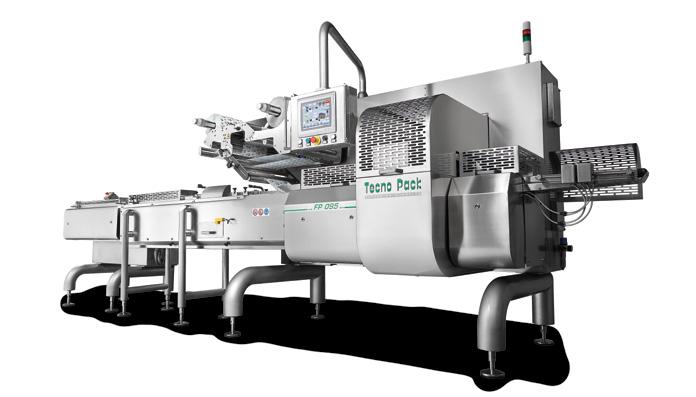


RESEARCH
Simultaneous detection of four main foodborne pathogens in ready-to-eat food
The increasing consumption of organic or ready-to-eat food may cause serious foodborne disease outbreaks. Developing microbiological culture for detection of food-borne pathogens is time-consuming, expensive, and laborious. Thus, alternative methods such as polymerase
chain reaction (PCR) are usually employed for outbreaks investi gation.

In this work published in the International Journal of Environmental Research and Public Health, Spanish Researchers aimed to develop a rapid and simple protocol for the simulta
neous detection of Escherichia coli (E coli), Listeria monocy togenes (L. monocytogenes), Staphylococcus aureus (S. au reus) and Salmonella enterica (S. enterica), by the combination of an enrichment step in a single culture broth and a multiplex PCR (mPCR) assay. The effec tiveness of several enrichment media was assessed by culture and PCR. Buffered peptone wa ter (BPW) was selected as the optimum one.
Then, mPCR conditions were optimized and applied both to pure co-cultures and artificially inoculated food samples (organ ic lettuce and minced meat). In the culture medium inoculated at 100 CFU/mL, mPCR was able to detect the four microorganisms. When performed on artificially food samples, the mPCR assy was able to detect E. coli, S. en terica, and L. monocytogenes. In conclusion, BPW broth can effec tively support the simultaneous growth of E. coli, S. aureus, L. monocytogenes, and S. enterica and could be, thus, used prior to a mPCR detection assay in ready-to-eat food, thereby con siderably reducing the time, ef forts and costs of analyzes.
54 italian food & packaging technology - cii (2022) - november
Natamycin, a biofungicide for managing major postharvest fruit decays of citrus
The antifungal polyene mac rolide natamycin was evaluated by US Researchers as a posthar vest biopesticide for citrus fruit and the results were publisged in Plant Disease journal.

Aqueous spray applications with 1,000 µg/ml were moderately to highly effective against green mold incidence after inoculation but did not reduce sporulation of Penicillium digitatum on in fected fruit. Treatments with na tamycin were significantly more effective against green mold on grapefruit and lemon than on orange and mandarin, with 92.9, 88.5, 57.5, and 60.9% reduc tions in decay, respectively, as compared with the control. The biofungicide was compatible with a storage fruit coating but was less effective when applied in a packing coating. However, when either fruit coating was applied following an aqueous natamycin treatment (i.e., staged applica tions), the incidence of decay was reduced to <=10.7% as compared with the untreated control (with 81.9%). The incidence of sour rot of lemon and mandarin was also significantly reduced from the untreated control by natamycin (1,000 µg/ml) but propiconazole (540 microg/ml) and propicona zole + natamycin (540 + 500 mµgi crog/ml) mixtures generally were significantly more effective than natamycin alone when using a severe inoculation procedure. Ex perimental and commercial pack ingline studies demonstrated that natamycin-fludioxonil or natamycin-propiconazole mixtures ap plied in a storage fruit coating or
as an aqueous flooder treatment were highly effective and typically resulted in a >85.0% reduction of green mold and sour rot. Resist ance to natamycin has never been documented in filamentous fungi. Thus, the use of natamycin, in contrast to other registered post harvest fungicides for citrus, can be an antiresistance strategy and an effective treatment in mixtures
with other fungicides for the man agement of major postharvest decays of citrus.
Use of oleogels to replace margarine in steamed and baked buns
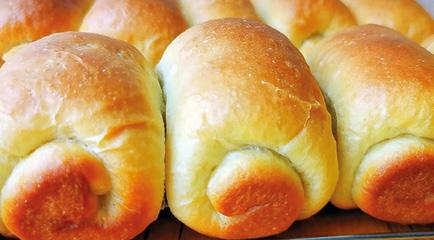
Bakery products are usually formulated with solid fats, like margarines and shortenings, which contain high levels of sat urated and trans-fatty acids and have negative effects on human health. In a study carried out by Spanish Researchers, hydroxy propyl methylcellulose (HPMC) and xanthan gum (XG) were used as oleogelators to prepare oleo gels, using sunflower and olive oil, as substitutes for margarine in baked or steamed buns.
The effect of oleogels on the physical properties of the buns was evaluated by analyzing the crumb structure, specific volume, height, and texture. In addition, a triangular discriminatory sensory test was conducted, and lipid di gestibility was assessed through in vitro digestion studies. Re placement of margarine with oleogels produced steamed buns with no differences in the crumb structure, volume, height, and
texture; however, in baked buns, a less porous and harder struc ture was produced. No differ ences in texture were observed between the margarine buns and buns made with oleogels when the triangular test was conduct ed. The extent of lipolysis was not affected when margarine was replaced by oleogels in the baked and steamed buns.
The results published in Foods journal suggest that using oleo gels instead of margarine in buns could represent an interesting strategy to prepare healthier bakery products
research italian food & packaging technology - cii (2022) - november 55
Genome-edited Saccharomyces cerevisiae strains for improving fermented foods

While Cas9-based genome ed iting enabled precise and sophis ticated genetic perturbations in conventional and non-conven tional yeast strains, its appli cations for food fermentations have been extremely limited.
In order to improve quality and flavor of various yeast-fermented foods, US Researchers isolat ed and engineered a diploid or polyploid Saccharomyces cerevi siae strain (N1) which exhibits ro bust sugar fermentation, strong acid tolerance, and rapid gas pro duction from Korean Nuruk.
First, RGT2 and SNF3 coding for glucose sensors were de leted to increase respiration. A bread dough fermented with the N1 DELTA RGT2 DELTA SNF3 strain showed an 18% in creased volume due to higher carbon dioxide production.
Second, ASP3 coding for as paraginase was overexpressed and URE2 coding for a transcrip tional factor of nitrogen catabo
lite repression (NCR) was deleted to increase asparagine consump tion. When the N1 DELTAURE2:: PGPD-ASP3 strain was applied to a potato dough, asparagine was rapidly depleted in the dough, re sulting in potato chips with negli gible amounts of acrylamide.
Third, the N1 DELTA URE2 strain was utilized to increase
levels of the amino acids which provide a savory taste during rice wine fermentation.
The above genome-edited yeast strains contain no heterol ogous DNA. As such, they can be used to improve fermented foods with no subjection to GM regula tion. This paper was published in Food Microbiology journal.
MICELLAR CASEIN AND CHEESE PRODUCT STORAGE
Micellar casein is a novel dairy protein ingredient that can be used in process cheese product (PCP). PCP is a dairy food prepared by blending dairy ingredients with nondairy ingredients and then heating the mixture with continuous agitation to produce a homogenized product with an extended shelf-life. The objective of the work published in LWT - Food Sci ence and Technology journal by US Researchers was to study the effect of storage of concentrated micellar ca sein (CMC) on the functionality of PCP. Three treatments of CMC (CMC; CMC + NaCl = CMC + 1% sodium chloride; CMC + NaCl + NaCit = CMC + 1% sodium chloride and 1%
trisodium citrate) were prepared and stored for 60 d at 4degreeC. The functionality of PCP was determined by measuring the end apparent viscosity, hardness, and melting temperature. This trial was replicated three times. The PCP made with different treatments of CMC during storage had an approximate range of 47.048.0% moisture and 5.7-5.8 pH (P < 0.05). The addition of sodium chloride and trisodium citrate to CMC during storage resulted in differences (P < 0.05) in the end apparent viscosity, hardness, and melting temperature of PCP. However, the storage of CMC did not show any differences (P > 0.05) in the functionality of PCP.
research 56 italian food & packaging technology - cii (2022) - november
The impact of plasma processing and pulsed electric field on the viability of probiotic yoghurt drink
In a study published in the Journal of Food Processing and Preservation, the properties of the milk treated with combina tion of solution plasma (SP) pro cessing and pulsed electric field (PEF) for different periods (5 and 10min) was investigated by Turk ish Researchers.
The microbiological, physic ochemical, and sensory prop erties of the probiotic yoghurt drink (Ayran) produced from these milks were determined during storage. PEF was per formed at voltage 3500V, repe tition 17,000Hz, and pulse width 2.58mus on the raw milk.
Lactobacillus acidophilus and Bifidobacterium animalis subsp. lactis probiotic cultures were used in production with conventional yoghurt bacteria Streptococcus thermophilus and Lactobacillus delbrueckii subsp. bulgaricus . In addition to the probiotic viability, texture and sensory quality in terms of con sumer preference were investi gated.
It was determined that the viscosity and dry matter values of the solution plasma-treated samples were lower compared to the samples produced by heat treatment, and these values de creased further with the increase in plasma application time. It was also found that the maximum increase in L* and b* values of all samples during storage was in the samples treated with plasma for 10min. The viability of the probiotic bacteria in probiotic Ayran samples were determined to be within the therapeutic level
(>6.27 log10 cfu ml-1) with higher scores for sensorial qualifica tions.
Consumers’ expectations of more nutritious and microbio logically safe food have enabled the development of new pro cessing technologies. Probiotic fermented milk products are products that provide health benefits in the prevention of gastrointestinal diseases, regu lation of metabolism, and stim ulation of the immune system. The processing of these dairy products with non-thermal technologies provides advan tages in preserving their func tional properties.
Smartphone biosensor for detection of ochratoxin A in wine and coffee
Exposure to mycotoxins, which may contaminate food and feed commodities, represents a serious health risk for consum ers. Ochratoxin A (OTA) is one of the most abundant and toxic mycotoxins, thus specific reg ulations for fixing its maximum admissible levels in foodstuff have been established. Lateral Flow ImmunoAssay (LFIA)-based devices have been proposed as screening tools to avoid OTA contamination along the whole food chain.
Italian Researchers report a portable, user-friendly smart phone-based biosensor for the detection and quantification of OTA in wine and instant coffee, which combines the LFIA ap proach with chemiluminescence (CL) detection. The device em ploys the smartphone camera as a light detector and uses low-cost, disposable analytical cartridges containing the LFIA strip and all the necessary reagents. The analysis can be carried out at the point of need by non-specialized

research italian food & packaging technology - cii (2022) - november 57
operators through simple manual operations. The biosensor al lows OTA quantitative detection in wine and coffee samples up to 25mug L-1 and with limits of detection of 0.3 and 0.1mug L-1, respectively, which are below the European law-fixed limits.

These results published in Analytica Chimica Acta journal demonstrate that the devel oped device can be used for routine monitoring of OTA con tamination, enabling rapid and reliable identification of positive samples requiring confirmatory analysis.
Effect of ozone and antimicrobial treatments on the shelf life of packaged cauliflower

A study carried out by Canadi an Researchers and published in the Journal of Food Science and Technology focuses on devel opment of modified atmosphere packaging for fresh-cut minimally processed cauliflower to increase its shelf-life and enhancing the on-farm value addition by utiliz ing perforated packaging films along with pretreatments with
ozonated water and antimicrobi als.
The samples were treated with ozonated water, oregano essential oil (antimicrobial), and cinnamon essential oil (antimi crobial). Based on preliminary treatments, the number of perforations made by special ly prepared tool was kept as 6 and 12, which represented 5.1 x
10-5 and 1.02 x 10-4% of the total surface area of packages. These perforated packaged samples were stored in cold room at 4°C temperature for 28 days. The shelf life and quality of treated cauliflower samples were com pared with untreated samples. The quality analysis of the sam ples was carried up to 28 days at 7 days intervals based on their weight loss, headspace gas com position, texture, pH, total sol uble solids, ascorbic acid, total phenolics, total microbial count, and sensory characteristics.
The quality analysis revealed that ozonated water-treated samples at 12 perforations and stored at 4°C for 28 days were most efficient in keeping it fresh without any significant reduction in quality as compared to the cauliflower stored for one week at normal conditions.
technology - cii (2022) - november
research italian food & packaging
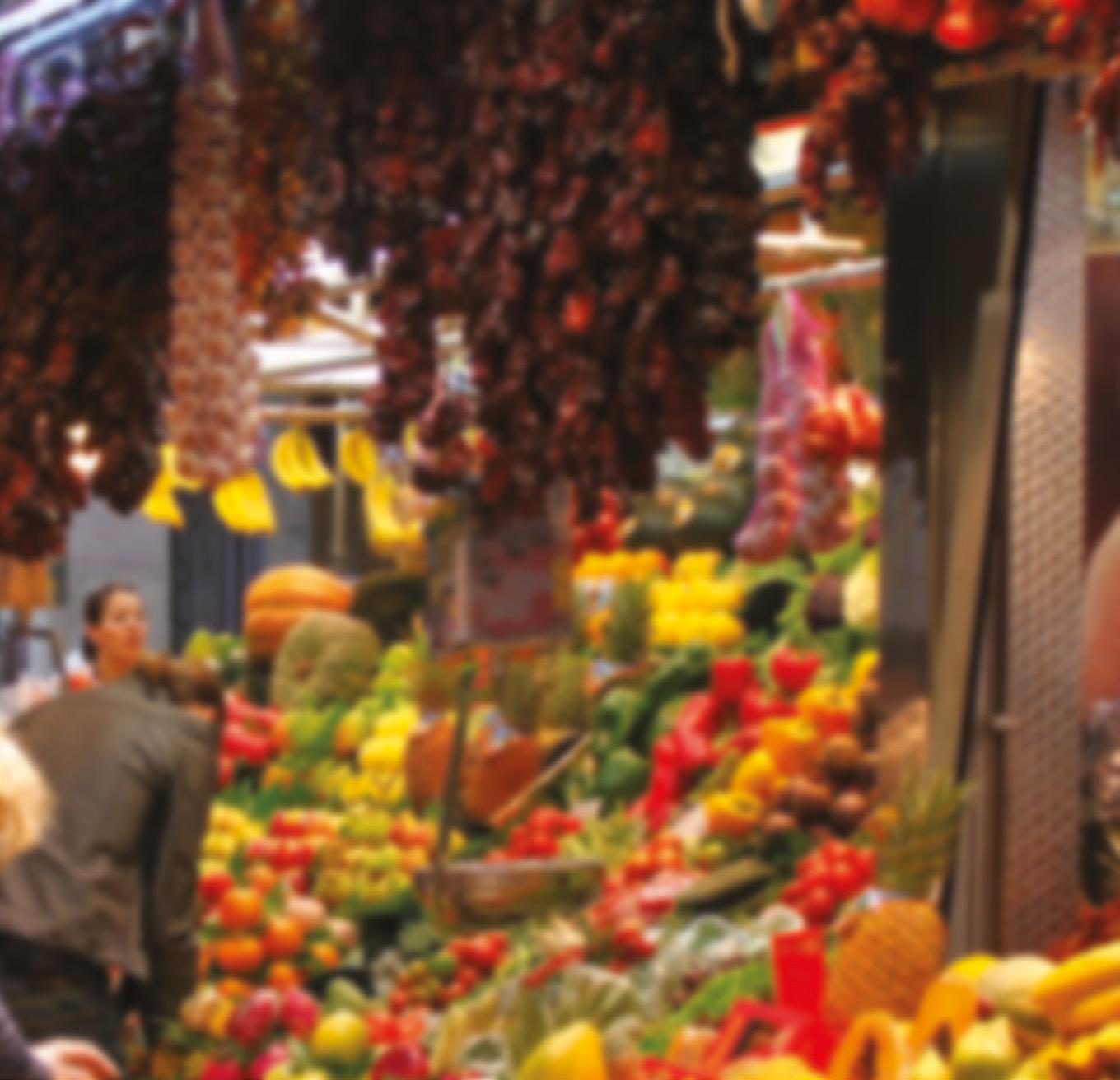
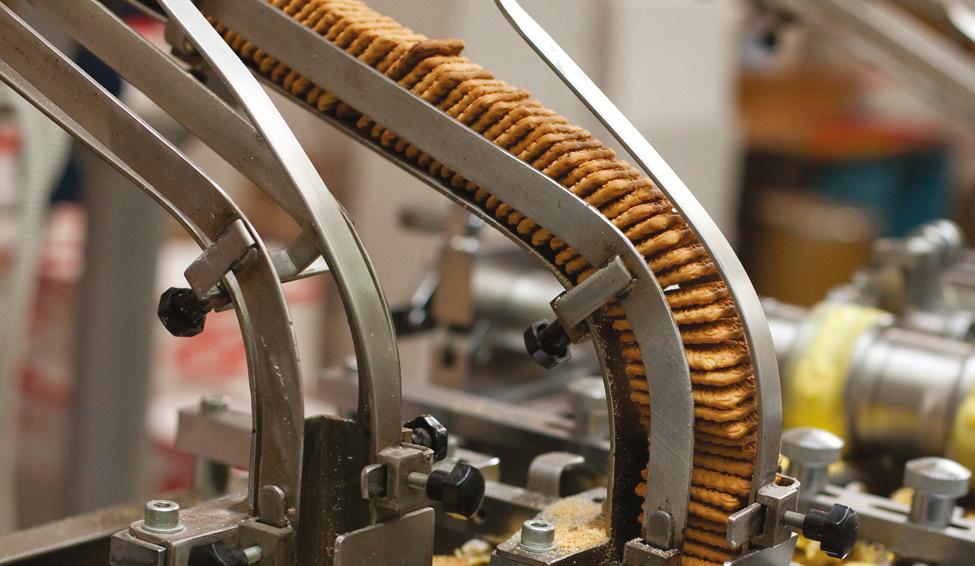



































Agenda AITA Analysis and Control Applied Research Automation and Electronics Beer Beverages Books Cereals Companies Conferences Energy and Sustainability Feed Food Food Safety Health and Wellness Hygiene Ingredients Laws Machines and Equipment Marketing Milling News Nutrition Packaging Pasta Soft Drinks Spirits Wine www.foodexecutive.com the latest news on the food&beverage world
Sigep 2023, the “dolce” communities begin the countdown
SIGEP – The Dolce World Expo, the 44th international trade show of artisan gelato, pastry, bakery and the coffee world, will be held at Rimini expo centre from 21st to 25th January. Simultaneously, also in Rimini, there will be the 7th edition of A.B. Tech Expo, dedicated to bakery technology and machinery, from storage to dough and preparation.

SIGEP will host all the historic chains with a layout occupying the entire expo centre, where the
collaboration with the sector’s artisan and industrial Associa tions, national and international associations of Master Gelato makers and pastry chefs and of bakers, baristas and coffee specialists will take form. Business, training, media aspects and projection on foreign markets, thanks to the support of the ITA-Italian Trade Agency, make SIGEP a true community catalyst that starts out from ingredients and products, the latest new ma
chinery and systems, and focus es increasingly greater attention on issues of sustainability and energy saving, furnishings and equipment, display cases and counters and everything neces sary for having contemporary packaging under the banner of the circularity of materials and flexibility for competitive mar keting increasingly integrated with digital platforms.
For over 40 years, SIGEP has also been synonymous with large international competitions that are an extraordinary tool for pro fessional training and discovering new talents. In the six “Arenas”, in ternational contests will alternate with demos by great Masters who use the most recent technological innovations and talks on training and culture. The Dolce Arena, the area of the key events, will host the competing talents of the Gelato Europe Cup, which is the pre liminary qualifying phase for the European teams leading up to the Gelato World Cup at Sigep 2024, the Junior World Pastry Championship, and the Ladies World Championship, which will elect the next Pastry Queen. In the Ge lato Arena, demos and talks. The Pastry Arena will host the Italian senior Championship and the Italian Junior Championship, as
60 italian food & packaging technology - cii (2022) - november NEWS
well as SIGEP Giovani. In the Coffee Arena, the best Italian baris tas will compete in seven national championships valid for the World Coffee Championship. The Bakery Arena on the other hand hosts the return of Bread in the City, the international bakery contest under the aegis of the Richemont Club. There will also be spectacle and flavour in the Choco Arena, with demos and talks by master chocolatiers and cacao experts talking about chocolate’s history and peculiarities.
2023 is the year of Sigep China
SIGEP’s increasingly inter national role as the platform of the Dolce community and the Italian way of life in the Out-ofHome consumption sector has also resulted in the first edition
of Sigep China, organized by Italian Exhibition Group in part nership with Koelnmesse, from 10th to 12th May 2023 at the Shenzhen World Exhibition and
Convention Center simultane ously with Anufood China to strategically cover the southern Chinese market.
www.sigep.it
Beer&Food Attraction and BBTech Expo to be held in February
Beer&Food Attraction, the eat ing out experience show, BBTech expo, the professional trade show for beer and beverage technolo gies, and Italgrob’s International Horeca Meeting will also be return ing to their ideal time slot.
The events, which gather to gether the entire OUT of Home industry, are scheduled to take place at Rimini Expo Centre from 19th to 22nd February 2023. New features at the next edition in clude a more extensive layout of
the shows, which will occupy the entire western part of the Expo Centre grounds. In addition to Italgrob, other strategic agree ments have also been confirmed with the Federazione Italiana Cuochi (Italian Cooks Federation); the sponsorship of Assobirra and the collaboration, among others, with CAST Alimenti. Staff at Italian Exhibition Group is also working on new partnerships that will be unveiled in the coming months.
www.bbtechexpo.com
INTERNATIONAL EVENTS IN ITALY
15-18 November 2022 - Rho (MI): Simei, beverage and wine industry show - www.simei.it
18-19 January 2023 - Bologna: Marca, private label food show - www.marca.bolognafiere.it
21-25 January 2023 - Rimini: Sigep, confectionery, pastry and ice cream show - www.sigep.it
19-22 February 2023 - Rimini: Beer&Food Attraction, beer and food show - www.beerattraction.it
29-30 March 2023 - Parma: Cibus Connect, food show - www.cibus.it
2-5 April 2023 - Verona: Sol&Agrifood, Italian food and olive oil show - www.vinitaly.com
2-5 April 2023 - Verona: Vinitaly, Italian wine showwww.vinitaly.com
3-5 May - 2023 - Rimini: Macfrut, fruit and vegetable processing exhibition - www.macfrut.com
5-7 May - 2023 - Bologna: Cosmofarma, functional and nutraceutical exhibition - www.cosmofarma.com
8-11 May 2023 - Milano: Tuttofood, food show - www. tuttofood.it
16-18 May 2023 - Milano: Packaging Première luxury packaging show - www.packagingpremiere.it
23-25 May 2023 - Parma: SPS Italia automation and digital show - www.spsitalia.it
13-17 October 2023 - Milano: Host, hospitality showwww.host.fieramilano.it
24-27 October 2023 - Parma: CibusTec, food processing show - www.cibustec.it
31 January – 3 February 2024 - Verona: Fieragricola, agricultural processing show - www.fieragricola.it
27-30 May 2025 - Rho (MI): Ipack-Ima, packaging, food processing and pasta exhibition - www.ipack-ima.com
italian food & packaging technology - cii (2022) - november
news
61
Macfrut 2023 with many new additions
The 40th edition of Macfrut, the international trade fair for the fruit and vegetable sector is scheduled to take place at the Rimini Expo Centre from 3 to 5 May 2023. The upcoming edition of this event, which is the only supply chain trade fair for pro fessionals in the fruit and vege table sector with a strong focus on both business and other con tents, marks a real turning point as it aims to become a leader in the sector: it will be a bigger trade fair, with two new exhibition halls; strong international growth with a target of 30% foreign profes sionals and 30 international pres entations; more contents, includ

ing focus sessions coordinated by experts in the field to ensure a high level of expertise while look ing at future trends.
What’s new at Macfrut 2023
International Blueberry Days will be a three-day event with the most prominent international technical and scientific experts, along with major global players including the US-based Driscoll’s, the number one nursery and fruit producer, and the Australian Costa Group, a leading blueberry breeder and producer.
Plant Nurseries and Varietal Innovation Exhibition, which will serve as a specialised meeting point for nurserymen, breeders, producers, experts and research ers operating in a field that has become strategically important for the development of modern fruit growing.
The Pianeta Rosso (Red Planet) is a new meeting format ded icated to players in the tomato supply chain, from seed compa nies to modern distributors.
The Biosolutions International Event, dedicated to natu ral products for plant protection, plant nutrition and biostimula tion. Biosolutions are a dynamic sector that is becoming more and more strategically important, which is why this event will in clude various activities for exhib itors and visitors.
AcquaCampus will be dedi cated to innovations in irriga tion and irrigation technolo gies. A test field will be set up in the exhibition halls to allow visitors to get a closer look at cutting-edge water manage ment technologies applied to horticulture, along with guided technical visits.
Spices & Herbs Global Expo is dedicated to the world of spices, medicinal herbs and aromatic herbs. This sector is growing at a rapid pace due to the fact that spices and herbs are becoming more and more frequently used for cooking.
The international focus will be on Latin America, which will take centre stage with the Latin American Days event, occupy ing an entire exhibition hall, with the participation of international businesses, institutions and professionals.
news 62 italian food & packaging technology - cii (2022) - november
www.macfrut.com




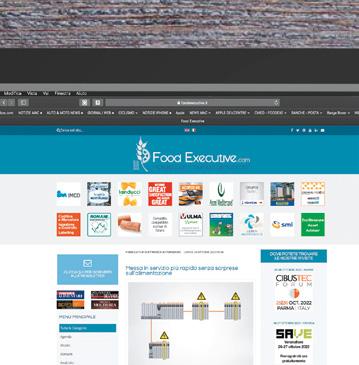






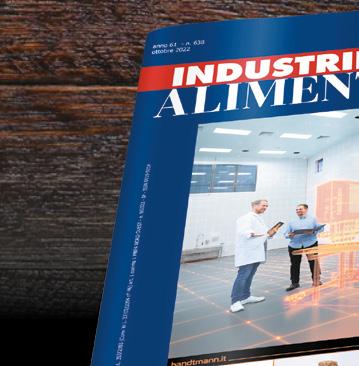

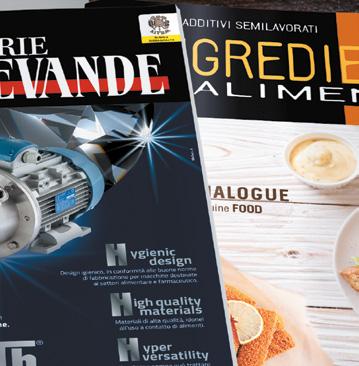



THE CORRECT TOOLS FOR THE BEST INFORMATION www.chiriottieditori.com

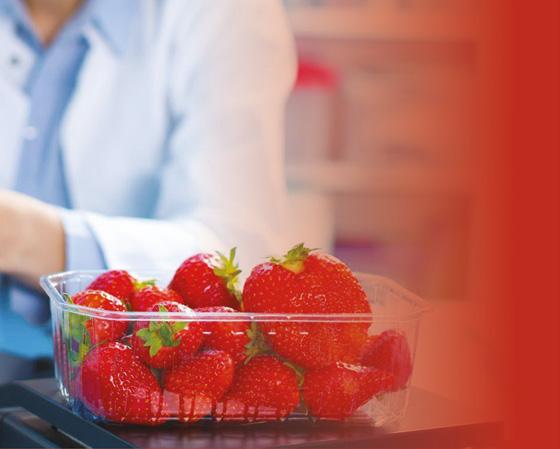






64 italian food & packaging technology - cii (2022) - november Company index Chiriotti Editori - Pinerolo - www.chiriottieditori.it ...................................... 63 Foodexecutive.com - Pinerolo - www.foodexecutive.com ............................ 59 General System Pack - Schio - www.gsp.it 33 Gerhard Schubert - Crailsheim (D) - www.schubert.group 28-29 HPP Italia - Parma - www.hppitalia.it.............................................................. 11 IFP Packaging - Schio - www.ifppackaging.it................................................. 43 Megadyne - Mathi - www.megadynegroup.com cover 3 P.E. Labellers - Porto Mantovano - www.pelabellers.com cover 2 Pigo - Vicenza - www.pigo.it .................................................................... cover 1 Pinco - Rancate (CH) - www.pinco-sa.com...................................................... 23 Sarp - Castelfranco V. - www.sarp.it 47 Smi - San Giovanni Bianco - www.smigroup.it 45 TECNO 3 - Corneliano d’Alba - www.tecno-3.it....................................... cover 4 Tecno Pack - Schio - www.tecnopackspa.it .................................................... 53 Wolhfarth - Sordio - www.wolhfarth.it 19 Colimatic ................................................................................. 46 Ebara Pumps Europe 24 Fava Giorgio Axel 20 Gerhard Schubert 38 I.Dea Pack 44 Megadyne Group 21 P.E. Labellers .......................................................................... 42 PIGO ......................................................................................... 16 Sarp 22 Servomech 18 SMI 40 Tecno 3 25 Advertiser index www.chiriottieditori.it/en/ VISIT OUR SITE SUBSCRIBE TO OUR NEWSLETTER AND TO OUR SOCIAL MEDIA, WE WILL KEEP YOU INFORMED SITO CHIED 2018 1-2.indd 2 16/05/18 12:19
The most frequent request from the Food industry is that the highest possible Food Safety and hygiene standards be maintained at every stage of the production process, from primary production to packaging. That’s why Megadyne developed the Metal & X-Ray Detectable Food Contact Timing Belts, a revolution in Food Grade belts.


































more, watch the video!




www.megadynegroup.com | info@megadynegroup.com Member of Ammega Group Aluminium Extrusion AgricultureCeramic Brick & Glass Fitness Meterial Handling Medical Industry Paper & Print Textile WoodFOOD PACKAGING
Discover
CONTINUOUS

AND MIXING




DOSING
A compact and versatile system: the Tecno3 continuous doser-mixer mod. MDC is used for a precise, homogeneous and constant dosing and mixing of liquid and solid ingredients. All the parts in contact with the product can be easily disassembled, removed and sanitized, thus ensuring the best process quality in a small footprint. Conveying the mixed product on the belt enables a leaner changeover and a significant reduction in cleaning times. www.tecno-3.it ACCURATE ACCURATE CONSTANT COMPACT VERSATILE Hall 03 Stand 3F91 04 - 10 Maggio 2023 Düsseldorf Let’s meet at: +39 0173 61.05.64 • www.tecno-3.it Headquarter: Tecno 3 S.r.l. - Corneliano d’Alba - ITALY Tecno 3 Switzerland Tecno 3 USA INC







































































































































































































































































































































































































































































